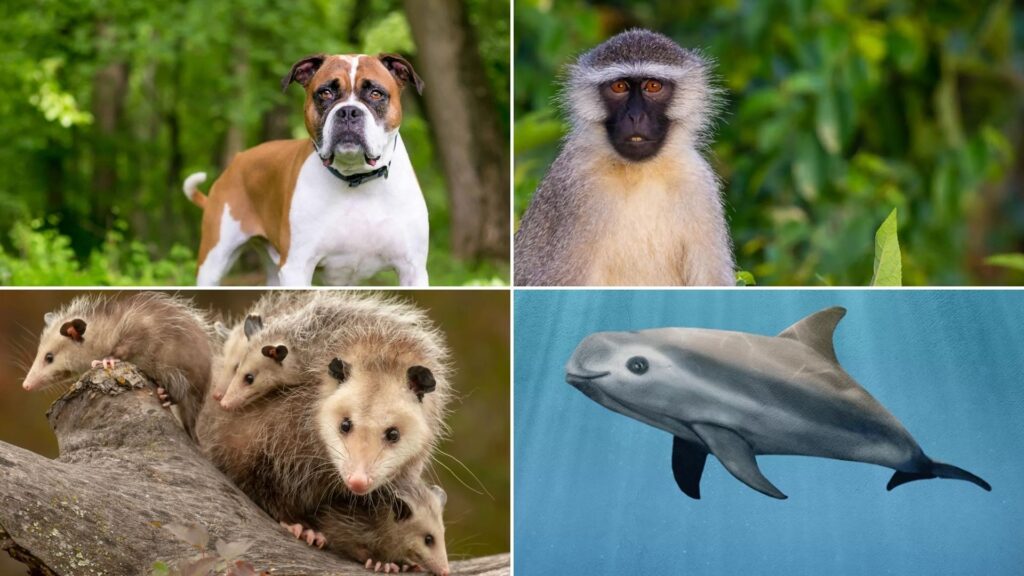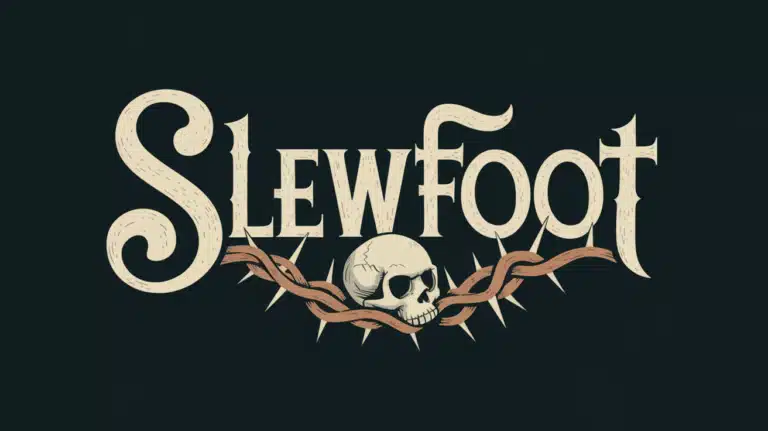Venture into the wild world of animals that start with V! From venomous vipers to vibrant vultures, the letter V reveals a variety of fascinating creatures.
Did you know there are over 30 animals whose names begin with this alphabet?
Imagine encountering a vampire bat or observing a vigilant vicuña in its natural habitat.
These V-named animals inhabit diverse ecosystems across our planet, each with its unique adaptations and behaviors.
Are you curious to learn more about these charming creatures? You’re in for an exciting exploration!
This blog will introduce you to 30 animals that start with V, revealing their unique features and interesting facts.
Animals That Start with V
Let’s start an engaging journey through the diverse world of animals whose names begin with the letter V.
This exciting group of creatures spans various habitats and includes species from tiny insects to large mammals.
Each animal featured here has unique adaptations and characteristics that make it stand out in the animal kingdom.
Discover the remarkable traits and engaging facts about these stunning animals, from the venomous viper to the versatile vole.
Let’s explore this alphabetic exploration and reveal the wonders of the animal world, one ‘V’ at a time.
1. Valley Bulldog

The Valley Bulldog is a sturdy, muscular dog with a stocky build and short legs.
A mix between a Boxer and an English Bulldog, these dogs are known for their friendly and loyal nature.
They have a brief, coarse coat in various colors, including brindle, fawn, and white.
Their wrinkled face and distinctive underbite give them a charming, expressive look.
- Region of Habitat: Nova Scotia, Canada
- Scientific Name: Canis lupus familiaris
- Place of Origin: Canada
- Feeding Habits: Omnivorous, mainly domestic dog food
- What Sound They Make: Barking
Fun Facts: These dogs are not good swimmers due to their stocky build and short legs, which makes them less buoyant in water.
2. Vampire Bat
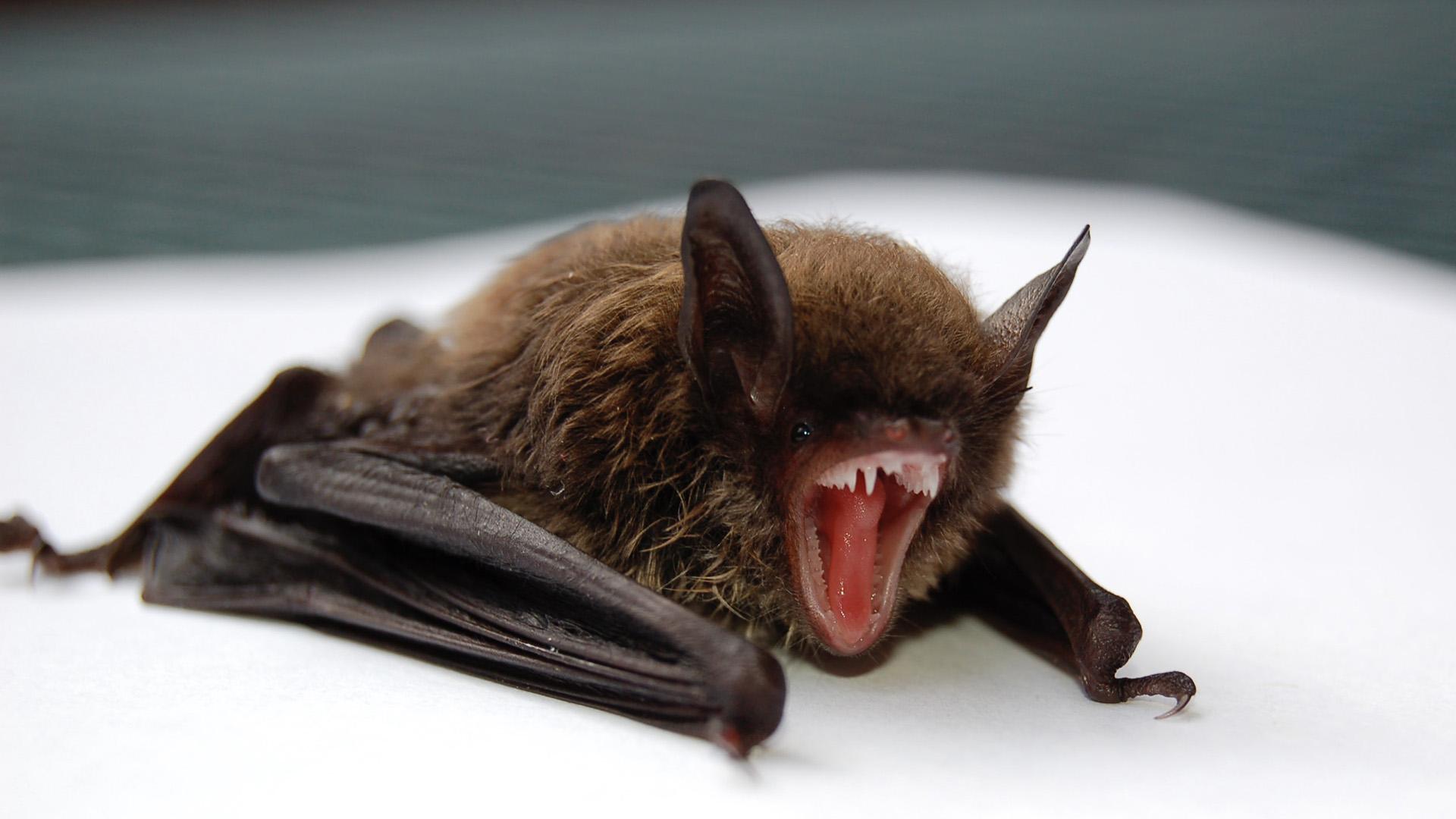
The Vampire Bat is a small, nocturnal mammal with a wingspan of 7-8 inches.
It uses its sharp teeth to make a small incision and then laps the blood with its tongue.
Its saliva contains a special enzyme that prevents blood from clotting while it feeds.
- Region of Habitat: Central and South America
- Scientific Name: Desmodontinae
- Place of Origin: Americas
- Feeding Habits: Hematophagous (feeds on blood)
- What Sound They Make: High-pitched squeaks
Fun Fact: Vampire bats have a heat sensor on the end of their noses, which locates blood vessels near the surface of their prey’s skin, ensuring efficient feeding.
3. Vampire Crab
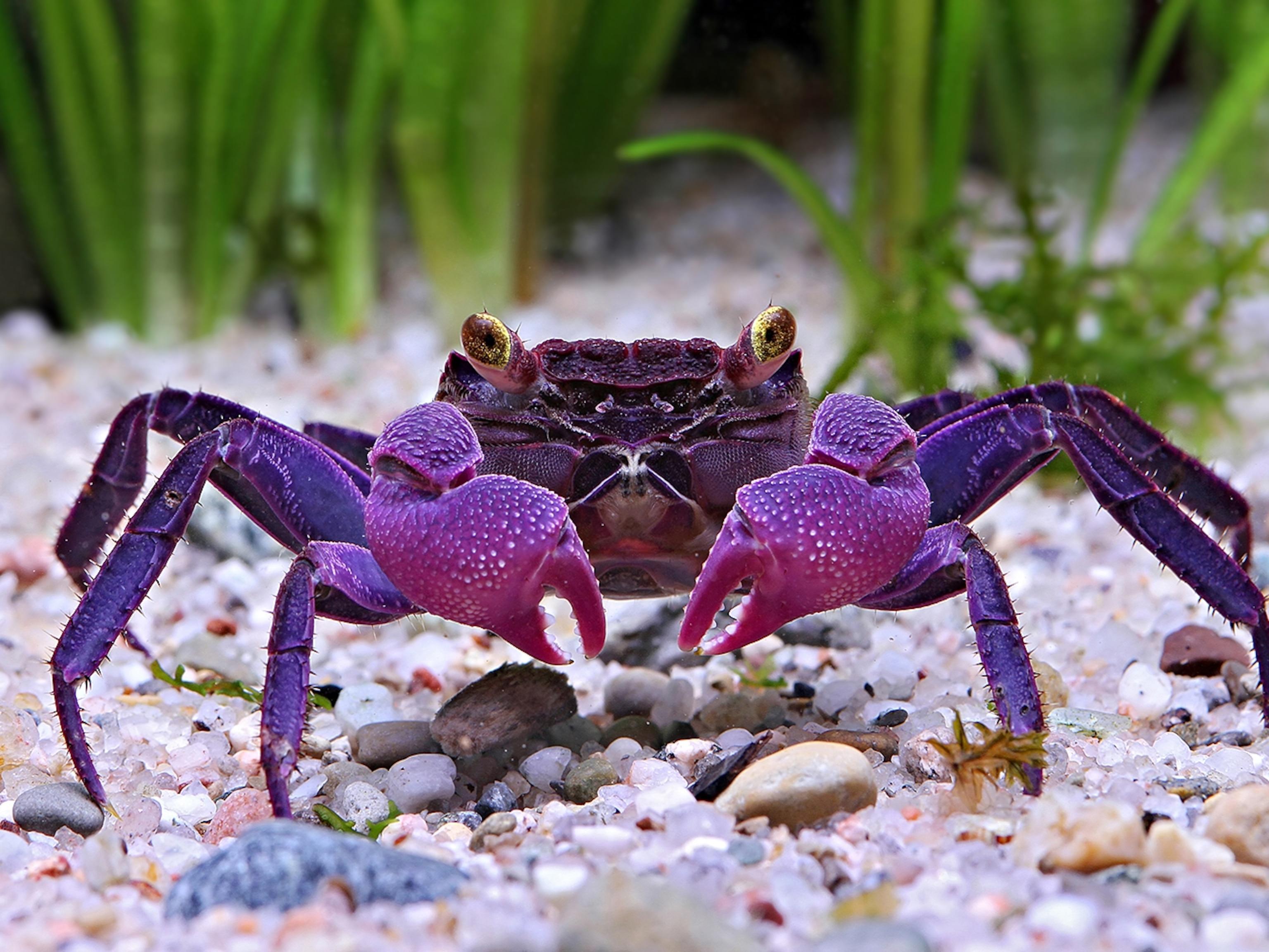
Vampire Crabs are small, strikingly colored crabs that live near freshwater rivers and forests.
They have flashy purple and orange shades and are popular in the pet trade due to their exotic appearance.
These crabs are relatively easy to care for, making them a favorite among aquarists.
- Region of Habitat: Southeast Asia
- Scientific Name: Geosesarma dennerle
- Place of Origin: Asia
- Feeding Habits: Omnivorous, feeds on plants and small invertebrates
- What Sound They Make: Silent
Fun Facts: Unlike most crabs, Vampire Crabs do not depend on saltwater for their development. They thrive in freshwater habitats.
4. Vampire Squid
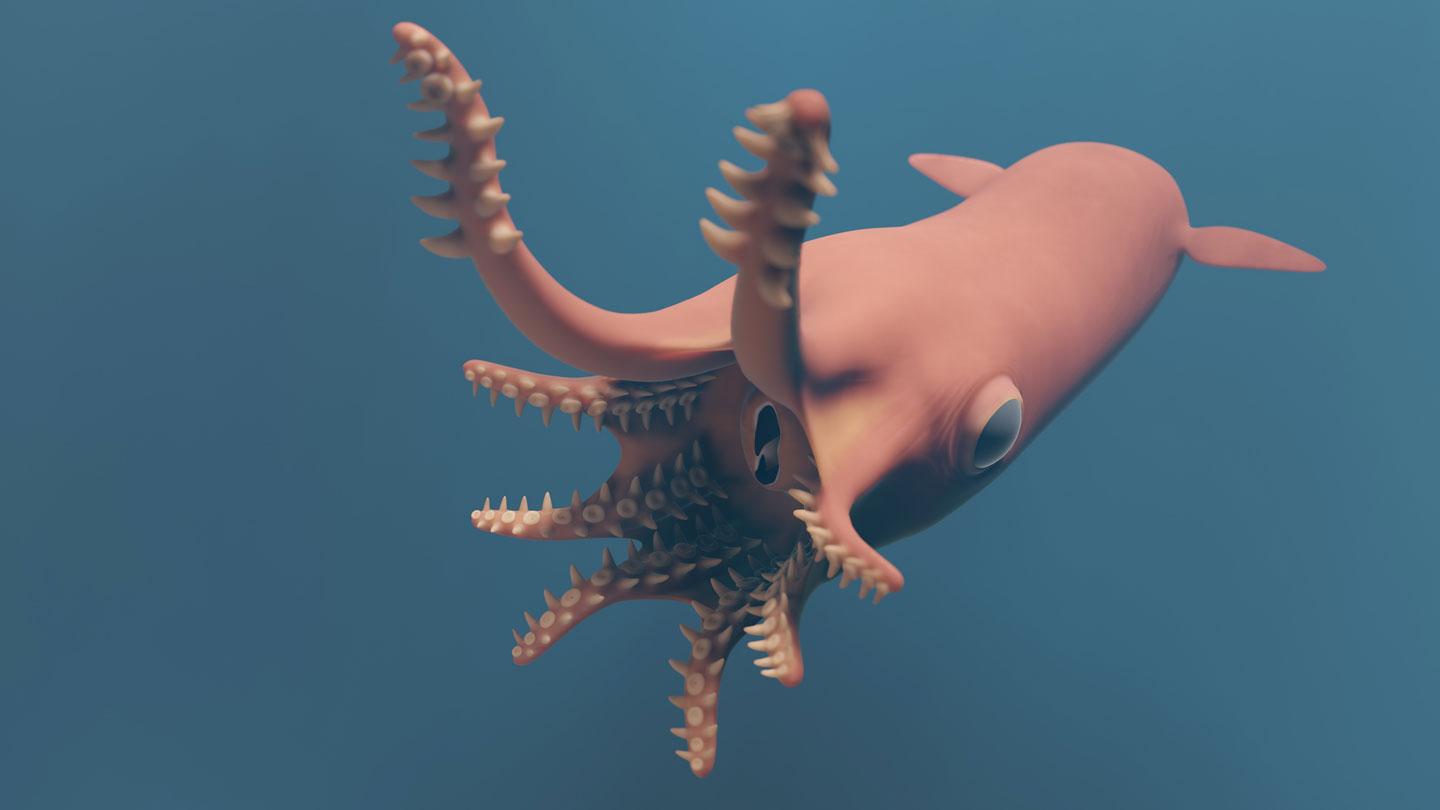
The Vampire Squid is a deep-sea cephalopod with a unique appearance. It features webbing between its arms and bioluminescent organs.
The vampire squid can survive in extremely low-oxygen environments thanks to its specialized respiratory system.
- Region of Habitat: Tropical and temperate oceans
- Scientific Name: Vampyroteuthis infernalis
- Place of Origin: Oceans worldwide
- Feeding Habits: Detritivorous, feeds on marine snow
- What Sound They Make: Silent
Fun Facts: Each of its eight arms has spines, and it uses two filaments to capture and eat its food, making it a proficient feeder in the deep sea.
5. Vaquita

The Vaquita is a small, elusive marine mammal with a distinctive facial marking and a small, stocky body.
It is critically endangered, with only a few individuals remaining in the northern Gulf of California.
The Vaquita’s population has declined due to illegal fishing practices, which have resulted in accidental entanglement in gillnets.
- Region of Habitat: Northern Gulf of California
- Scientific Name: Phocoena sinus
- Place of Origin: Mexico
- Feeding Habits: Carnivorous, feeds on fish and squid
- What Sound They Make: Clicks and whistles
Fun Facts: The Vaquita is the smallest cetacean and is known for being one of the rarest marine mammals in the world. Conservation efforts are ongoing to protect this species from extinction.
6. Veery
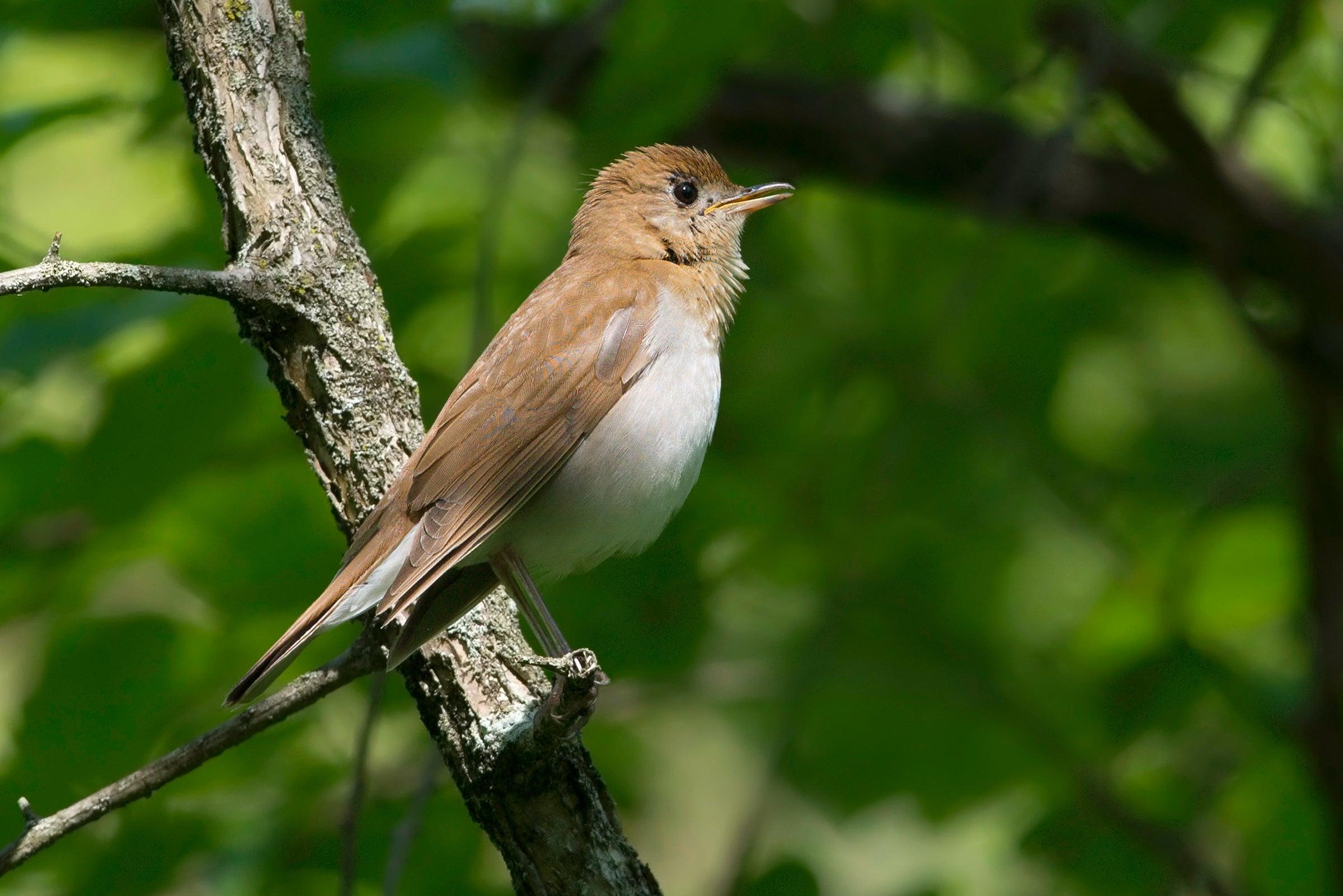
The Veery is a small, migratory songbird with a reddish-brown back and a spotted chest. It is known for its distinctive “veer” call and primarily feeds on insects and berries.
Veeries migrate long distances between their North American breeding grounds and wintering grounds in South America.
- Region of Habitat: North and South America
- Scientific Name: Catharus fuscescens
- Place of Origin: Americas
- Feeding Habits: Insectivorous and frugivorous
- What Sound They Make: Melodic, flute-like call
Fun Facts: The Veery is named for its sharp “veer” call, often heard during its migratory journeys through forested areas. This call helps them communicate with other Veeries in their vicinity.
7. Vegavis
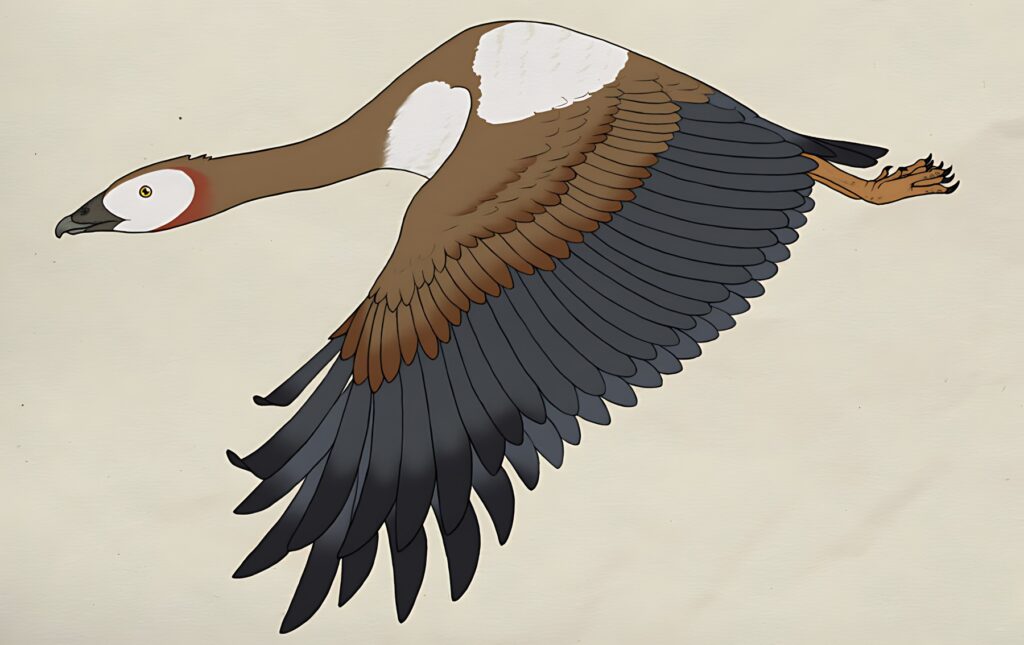
Vegavis is an extinct genus of birds that lived in Antarctica during the Late Cretaceous Period.
These birds were closely related to modern ducks and geese and had a specialized sound-producing organ.
Vegavis provides important insights into modern birds’ evolution and vocalization abilities.
- Region of Habitat: Antarctica (fossils)
- Scientific Name: Vegavis iaai
- Place of Origin: Antarctica
- Feeding Habits: Presumed omnivorous
- What Sound They Make: Unknown, presumed calls similar to modern ducks
Fun Facts: Vegavis is believed to be one of the earliest birds to have a sound-producing organ, indicating advanced vocalization abilities.
This discovery helps scientists understand the evolutionary history of bird communication.
8. Velociraptor
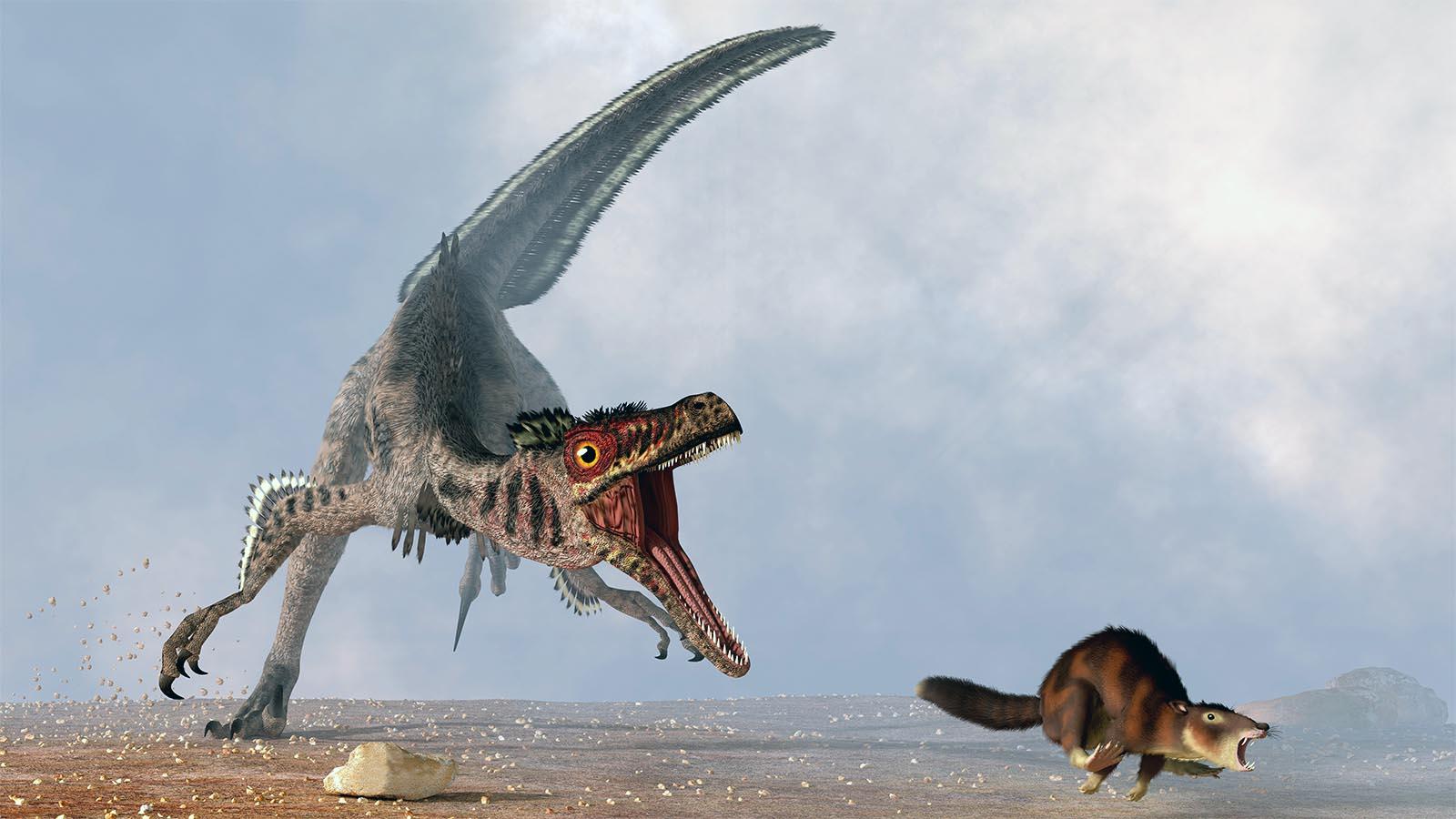
The Velociraptor was a small but fierce theropod dinosaur about 6 feet long. Its slender body, long tail, and sharp claws made it a formidable predator of its time.
Velociraptors were covered in feathers, which provided insulation and may have been used for display.
- Region of Habitat: Mongolia and China (fossils)
- Scientific Name: Velociraptor mongoliensis
- Place of Origin: Asia
- Feeding Habits: Carnivorous
- What Sound They Make: Unknown, presumed hissing and screeching
Fun Facts: Velociraptors were intelligent and used complex hunting strategies to capture prey.
Their agility and speed made them effective predators despite their relatively small size.
9. Virginia Opossum
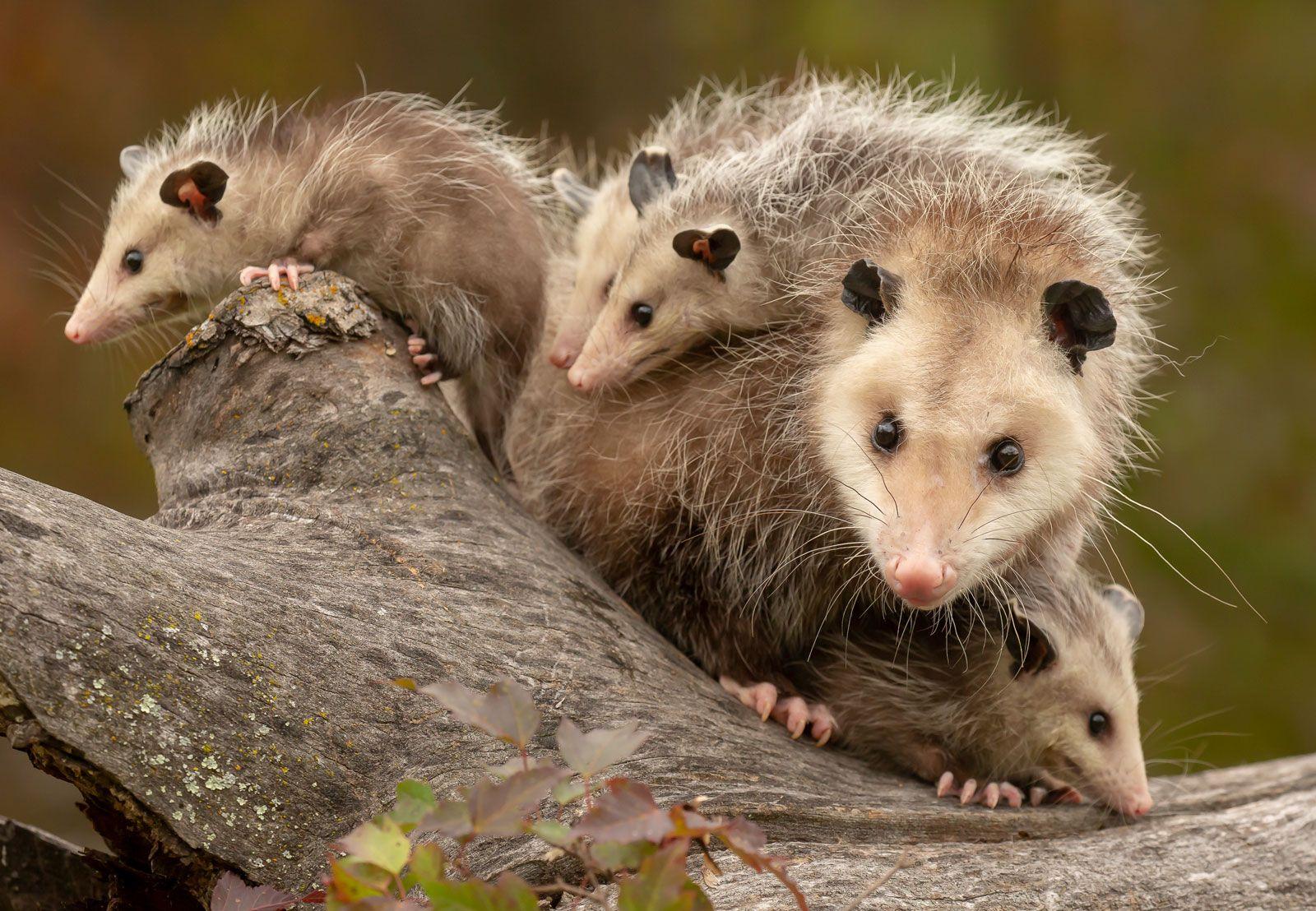
The Virginia Opossum, also known simply as the opossum, is the only marsupial found in North America.
It is known for its ability to play dead as a defense mechanism, often called “playing possum.”
These nocturnal animals have a white face with a pointed snout and a body covered in grayish fur. Their prehensile tail helps them balance and grasp objects.
- Region of Habitat: North America
- Scientific Name: Didelphis virginiana
- Place of Origin: United States
- Feeding Habits: Omnivorous, feeds on fruits, insects, small animals, and carrion
- What Sound They Make: Hissing, growling, and clicking sounds
Fun Facts: The Virginia Opossum is notable for having many teeth—50 in total, more than any other North American mammal.
They also have a remarkable immune system that makes them resistant to many diseases, including rabies.
10. Vermilion Flycatcher
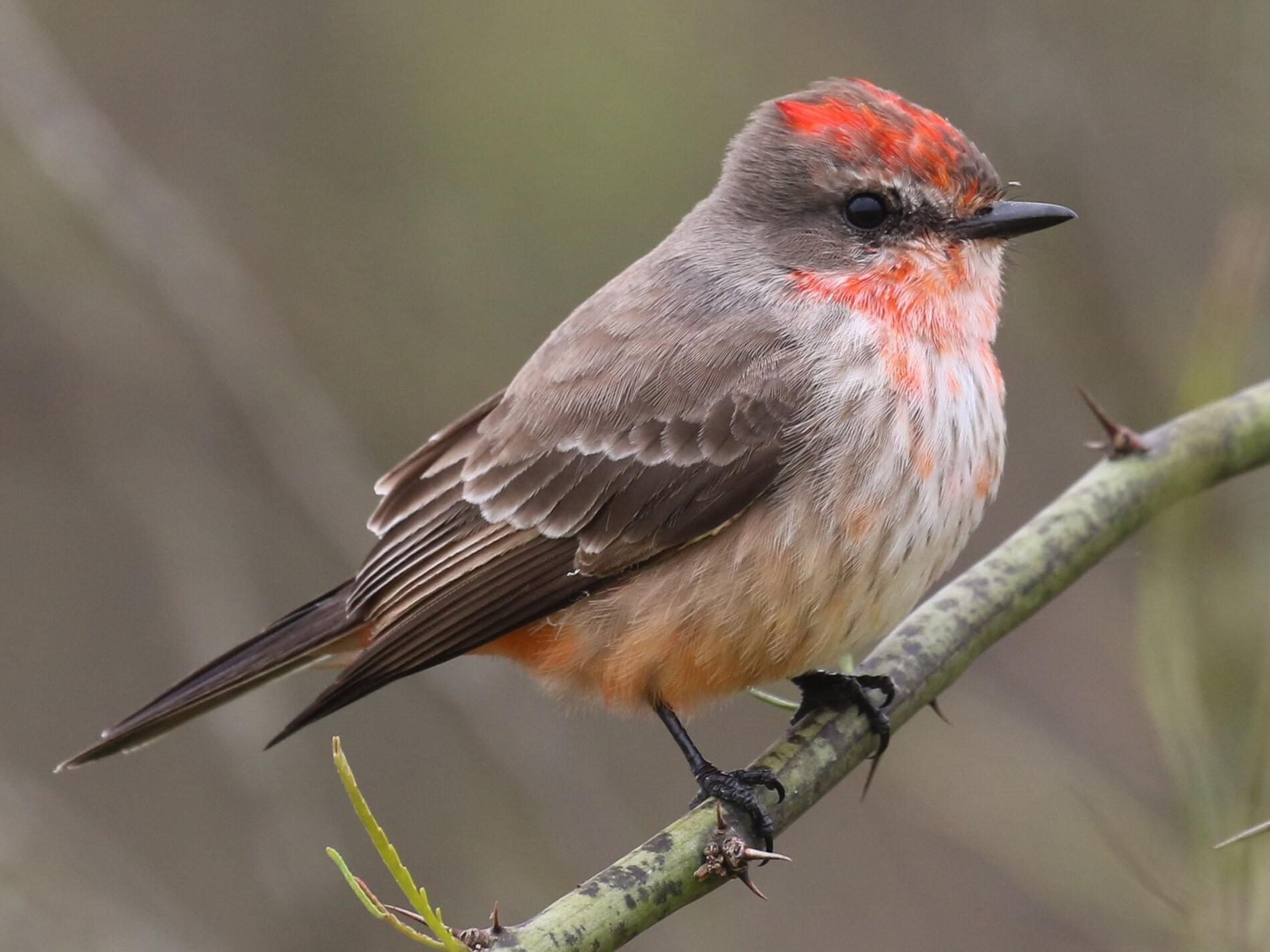
The Vermilion Flycatcher is a brightly colored bird found in the Americas. Males have vivid red feathers, while females are more subdued.
They are often seen catching insects mid-air. The Vermilion Flycatcher is known for its energetic and acrobatic flight patterns.
- Region of Habitat: North and South America
- Scientific Name: Pyrocephalus obscurus
- Place of Origin: Americas
- Feeding Habits: Insectivorous
- What Sound They Make: Fast, high-pitched song
Fun Facts: Vermilion Flycatchers have a distinctive and fast song that can last up to 10 syllables, making them easily identifiable by their vocalizations.
11. Vervet Monkey
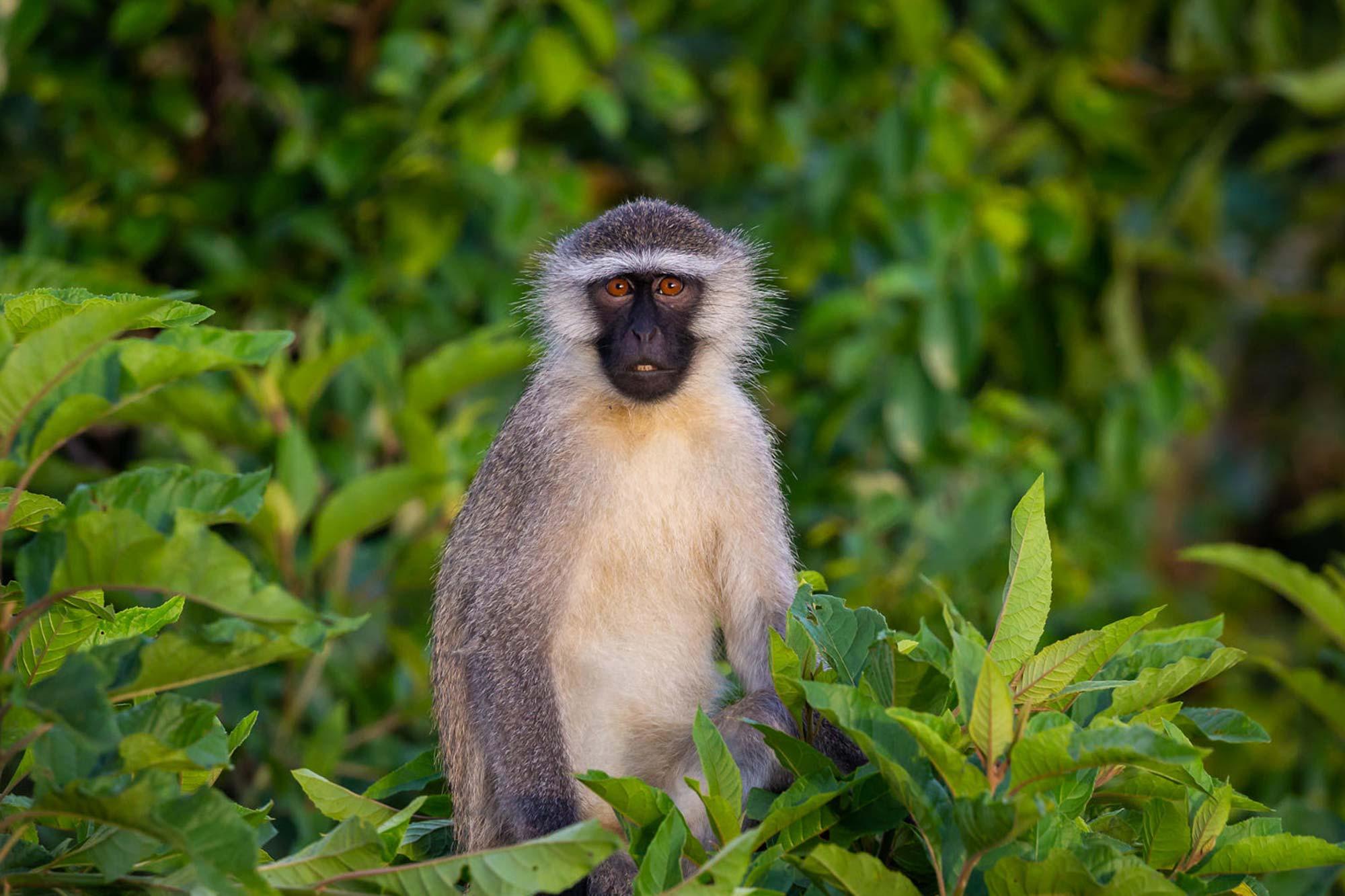
The Vervet Monkey is a medium-sized primate with a greyish-green body and a black face.
It lives in complex social structures and is known for its vocal communication and arboreal lifestyle.
Vervet Monkeys are found primarily in the savannas and woodlands of Eastern Africa.
- Region of Habitat: Eastern Africa
- Scientific Name: Chlorocebus pygerythrus
- Place of Origin: Africa
- Feeding Habits: Omnivorous, feeds on fruits, leaves, and insects
- What Sound They Make: Chattering and calls
Fun Facts: Vervet Monkeys have been studied extensively for their sophisticated social behaviors and communication, including specific alarm calls for different predators.
12. Vestal Cuckoo Bumblebee
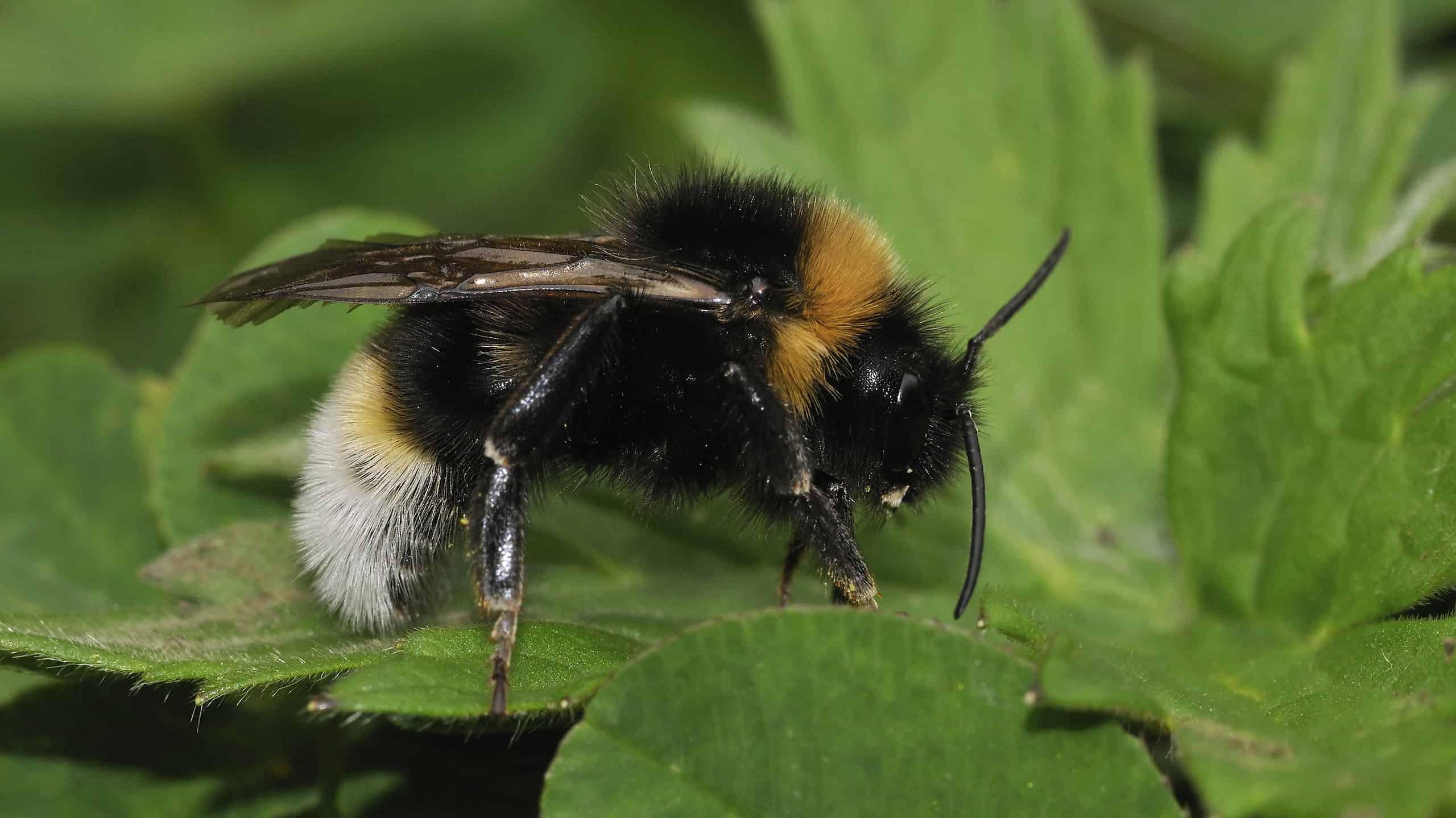
The Vestal Cuckoo Bumblebee is a parasitic bee that lays its eggs in the nests of other bumblebee species.
It is found in various parts of Europe, Northern Africa, and Western Asia. These bees do not construct their nests and rely on the host workers to raise their larvae.
- Region of Habitat: Europe, Northern Africa, Western Asia
- Scientific Name: Bombus vestalis
- Place of Origin: Europe and surrounding regions
- Feeding Habits: Parasitic, relies on host bees
- What Sound They Make: Buzzing
Fun Facts: Vestal Cuckoo Bumblebees have evolved to mimic the appearance and scent of their host bees, allowing them to infiltrate nests and lay their eggs undetected.
13. Vicuña
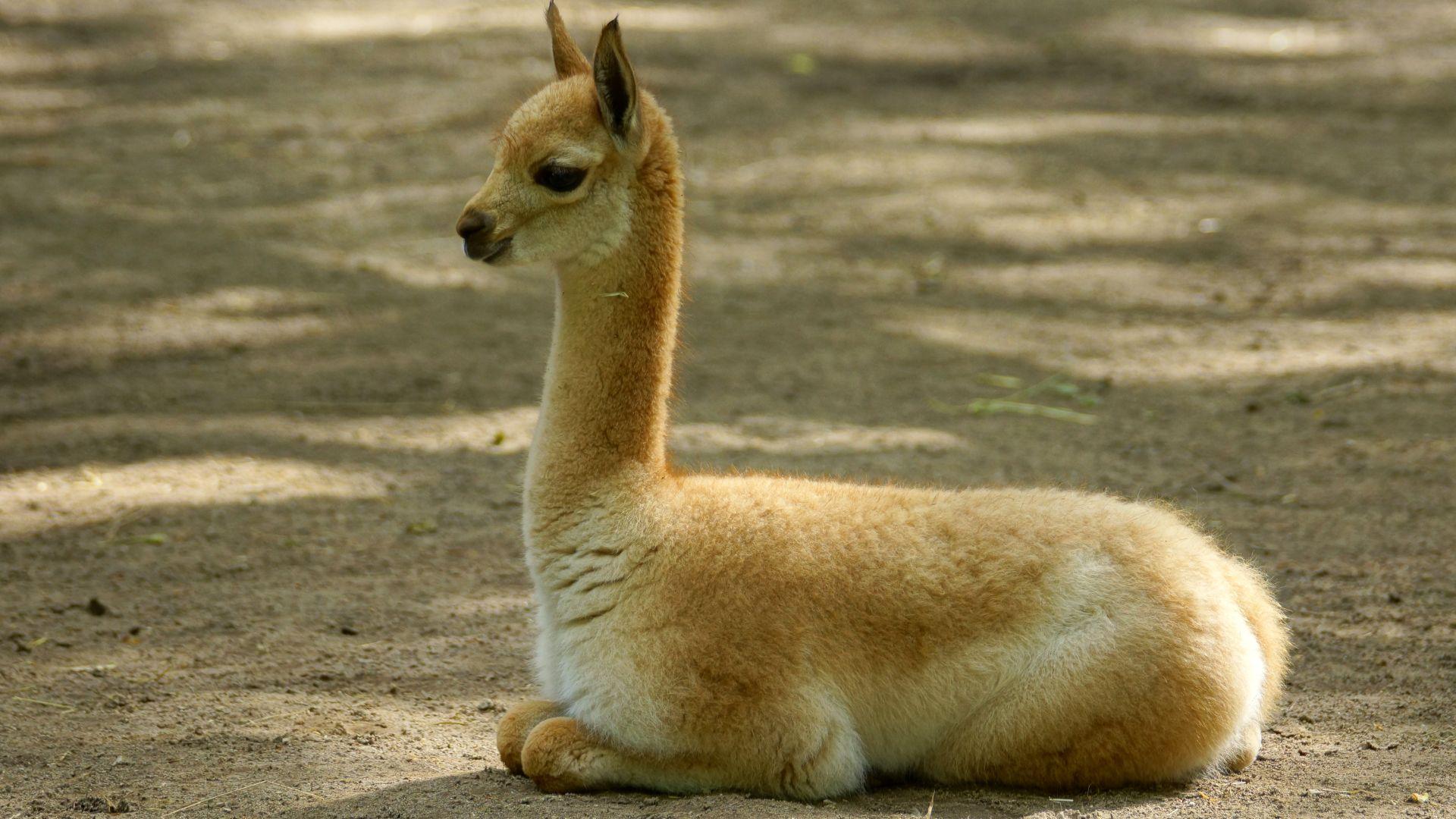
The Vicuña is a wild South American camelid with fine wool. It has a slender body, a long neck, and light brown fur.
Vicuñas live in the high Andes and are known for their valuable wool. They graze on grasses and other vegetation in the alpine regions.
- Region of Habitat: Andes Mountains, South America
- Scientific Name: Lama Vicugna
- Place of Origin: South America
- Feeding Habits: Herbivorous, feeds on grasses and vegetation
- What Sound They Make: Whistling calls
Fun Facts: Vicuñas produce some of the softest wool in the animal kingdom, which is highly prized for its quality.
To prevent harm to the animal, their wool can only be shorn every three years.
14. Vine Snake
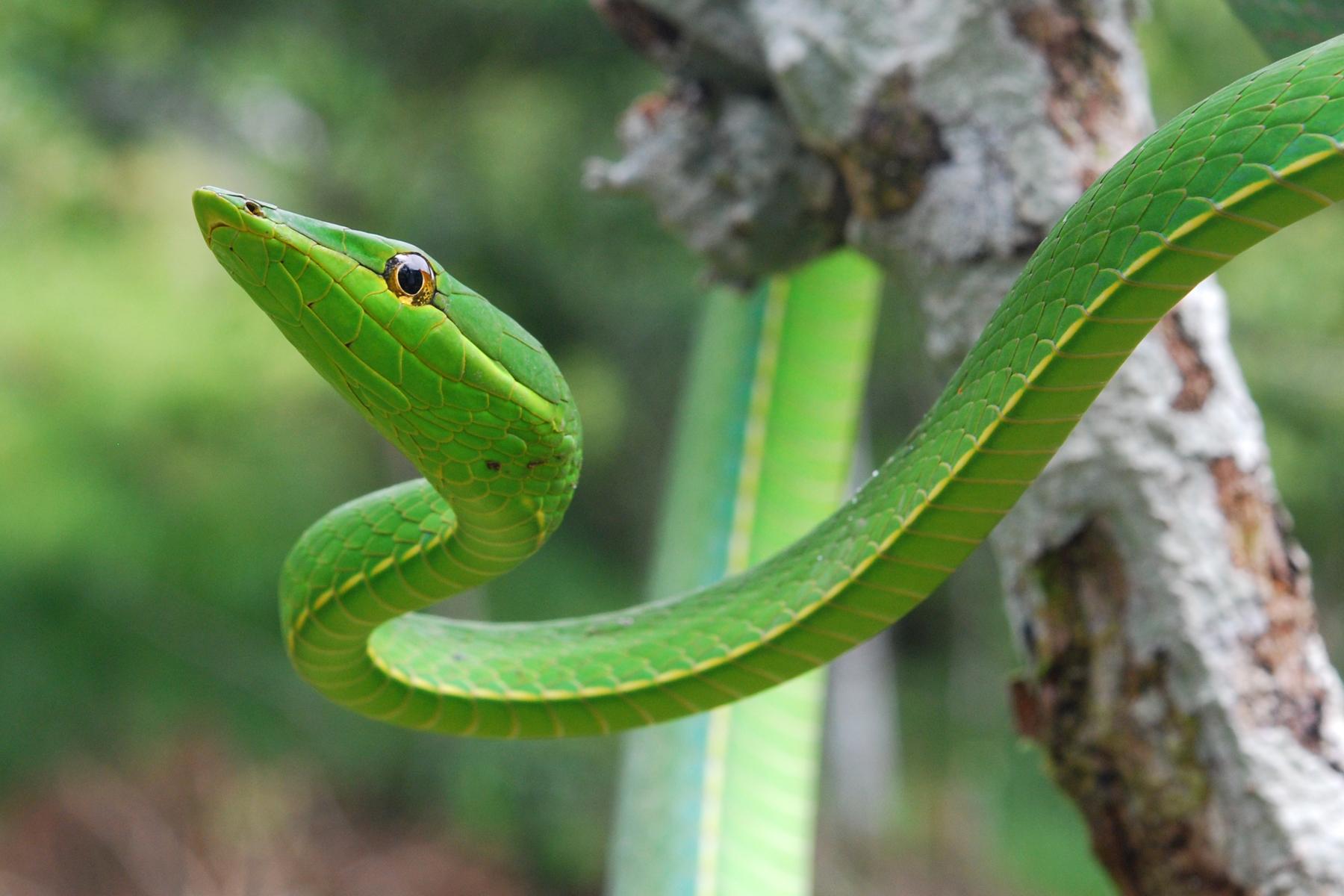
Vine Snakes are slender, arboreal snakes with long bodies and sharp vision.
They use camouflage to blend in with their surroundings and ambush prey.
Vine Snakes are found in various parts of Asia, Africa, and the Americas.
- Region of Habitat: Asia, Africa, and the Americas
- Scientific Name: Ahaetulla nasuta
- Place of Origin: Various regions worldwide
- Feeding Habits: Carnivorous, feeds on small animals
- What Sound They Make: Hissing
Fun Facts: The vine snake’s slender body and elongated snout give it a royal look.
Its excellent camouflage skills make it nearly invisible in its natural habitat.
15. Vinegaroon
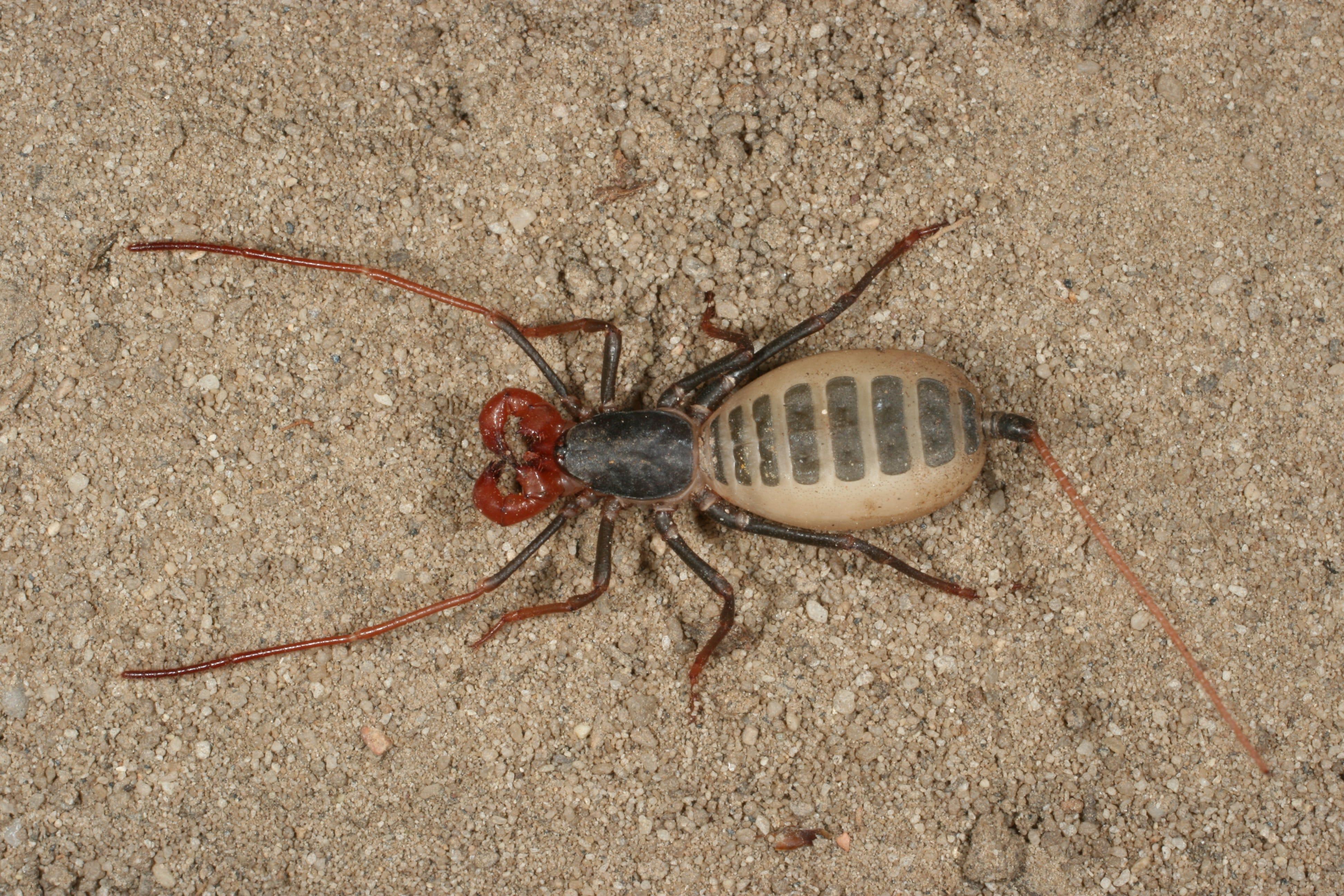
The Vinegaroon, also known as the whip scorpion, is an arachnid that can spray a vinegar-like substance as a defense mechanism.
It is found in warmer regions worldwide. Despite its intimidating appearance, the Vinegaroon is harmless to humans.
- Region of Habitat: Warm regions worldwide, except Australia and Europe
- Scientific Name: Thelyphonida
- Place of Origin: Various warm regions
- Feeding Habits: Carnivorous, feeds on insects and small animals
- What Sound They Make: Silent
Fun Facts: Vinegaroons can spray 19 times before their glands are depleted, using this defense to deter predators. Their spray contains acetic acid, the main ingredient in vinegar.
16. Viper
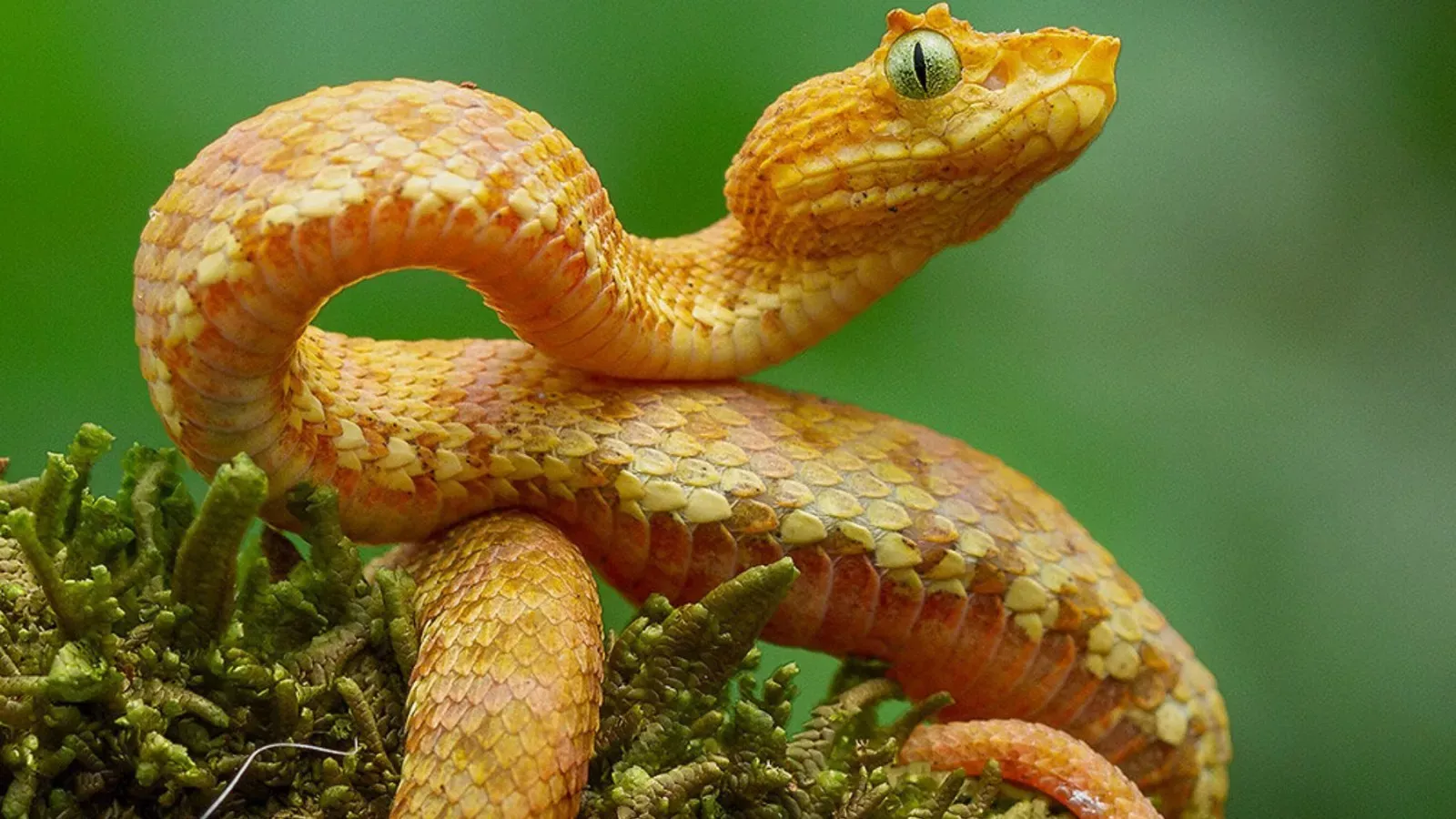
Vipers are venomous snakes known for their long, hinged fangs and potent venom.
They inhabit various environments worldwide, from deserts to forests. Vipers have a distinctive triangular head and vertical pupils.
- Region of Habitat: Europe, Asia, Africa, and the Americas
- Scientific Name: Viperidae
- Place of Origin: Various regions worldwide
- Feeding Habits: Carnivorous, feeds on small animals and birds
- What Sound They Make: Hissing
Fun Facts: Vipers are highly adaptable and thrive in diverse environments, from tropical rainforests to arid deserts. They are one of the most widespread groups of venomous snakes.
17. Viper Boa
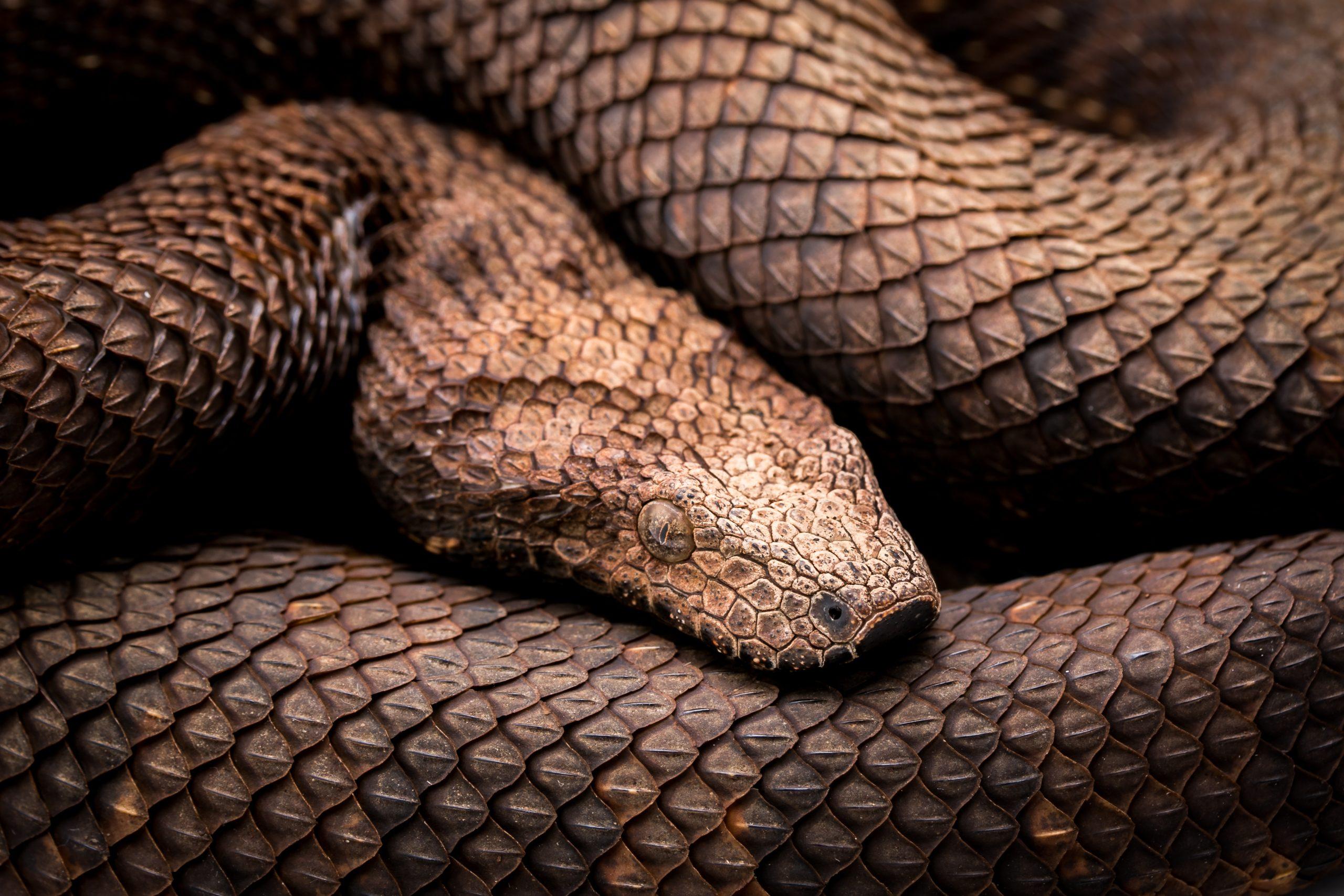
The Viper Boa, or the Papuan Ground Boa, is a nonvenomous constrictor native to New Guinea.
Despite its name, it is not a viper but resembles one in appearance. Viper Boas are nocturnal and slow-moving, often hunting small mammals and birds at night.
- Region of Habitat: New Guinea
- Scientific Name: Candoia aspera
- Place of Origin: New Guinea
- Feeding Habits: Carnivorous, feeds on small mammals and birds
- What Sound They Make: Hissing
Fun Facts: These boas are known as “lazy snakes” due to their slow movements.
Their unique appearance makes them look like venomous vipers.
18. Viper Shark (Dogfish)
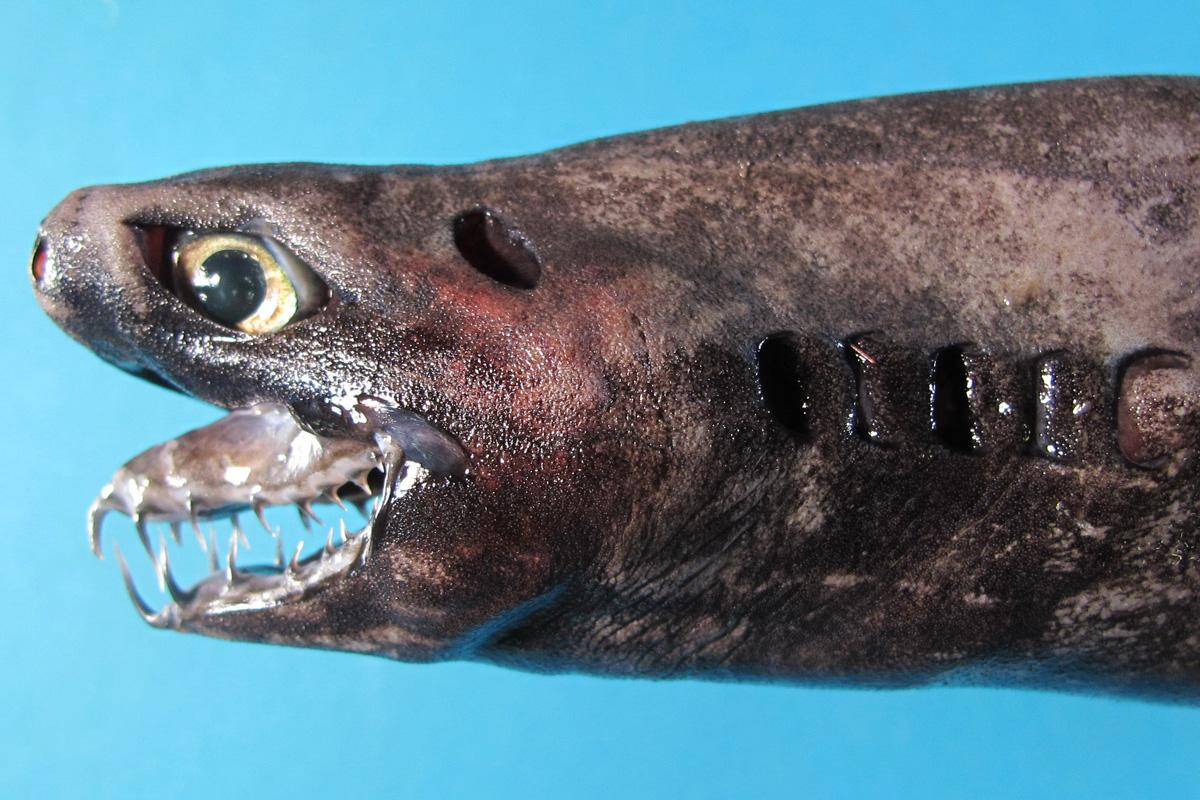
The Viper Shark, also known as the Viper Dogfish, is a deep-sea fish with long, sharp fangs and bioluminescent organs. Due to its deep-sea habitat, it is rarely seen.
Viper Sharks have a sleek, black body that helps them blend into the dark ocean depths.
- Region of Habitat: Deep-sea regions near Japan
- Scientific Name: Trigonognathus kabeyai
- Place of Origin: Japan
- Feeding Habits: Carnivorous, feeds on smaller fish
- What Sound They Make: Silent
Fun Facts: Most data on these elusive fish are based on observations near Japan, making them one of the least understood deep-sea creatures.
Their bioluminescent organs help attract prey in the dark depths.
19. Viperfish
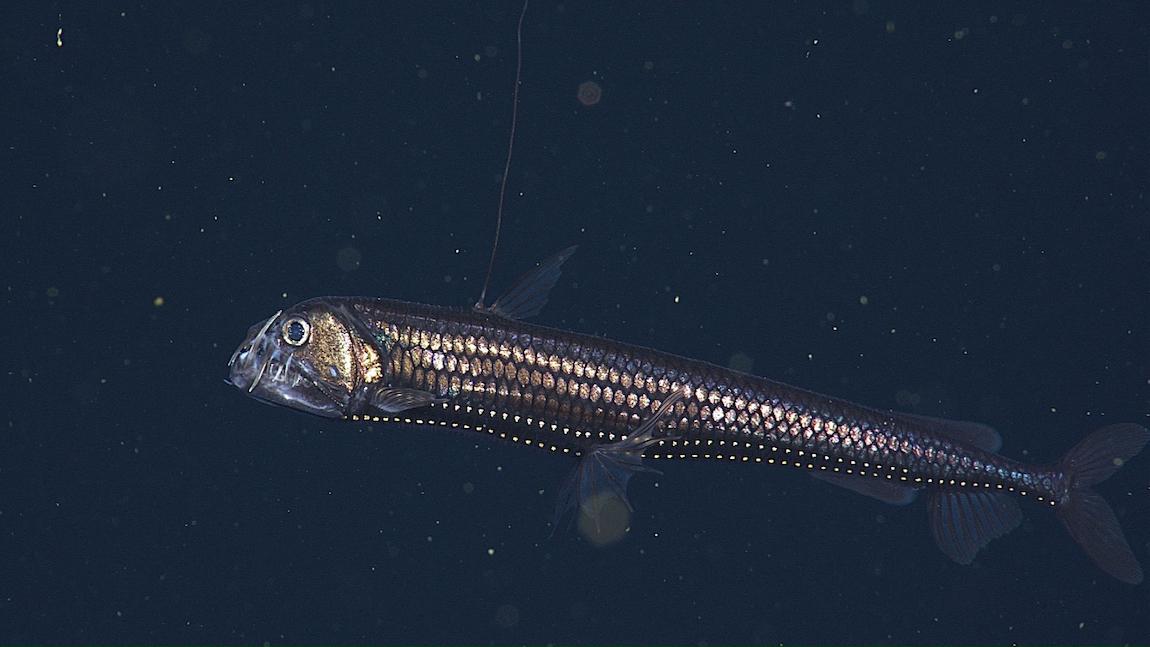
Viperfish are deep-sea predators with long, needle-like teeth and bioluminescent bodies.
They inhabit the deep waters of the world’s oceans. Their long dorsal fin spine radiates light to lure prey.
- Region of Habitat: Deep-sea areas worldwide
- Scientific Name: Chauliodus sp.
- Place of Origin: Worldwide
- Feeding Habits: Carnivorous, feeds on smaller fish and crustaceans
- What Sound They Make: Silent
Fun Facts: Viperfish can survive at depths of up to 9,000 feet, where sunlight does not penetrate.
Their bioluminescent lure attracts prey in the pitch-black environment of the deep sea.
20. Virgin Islands Dwarf Gecko
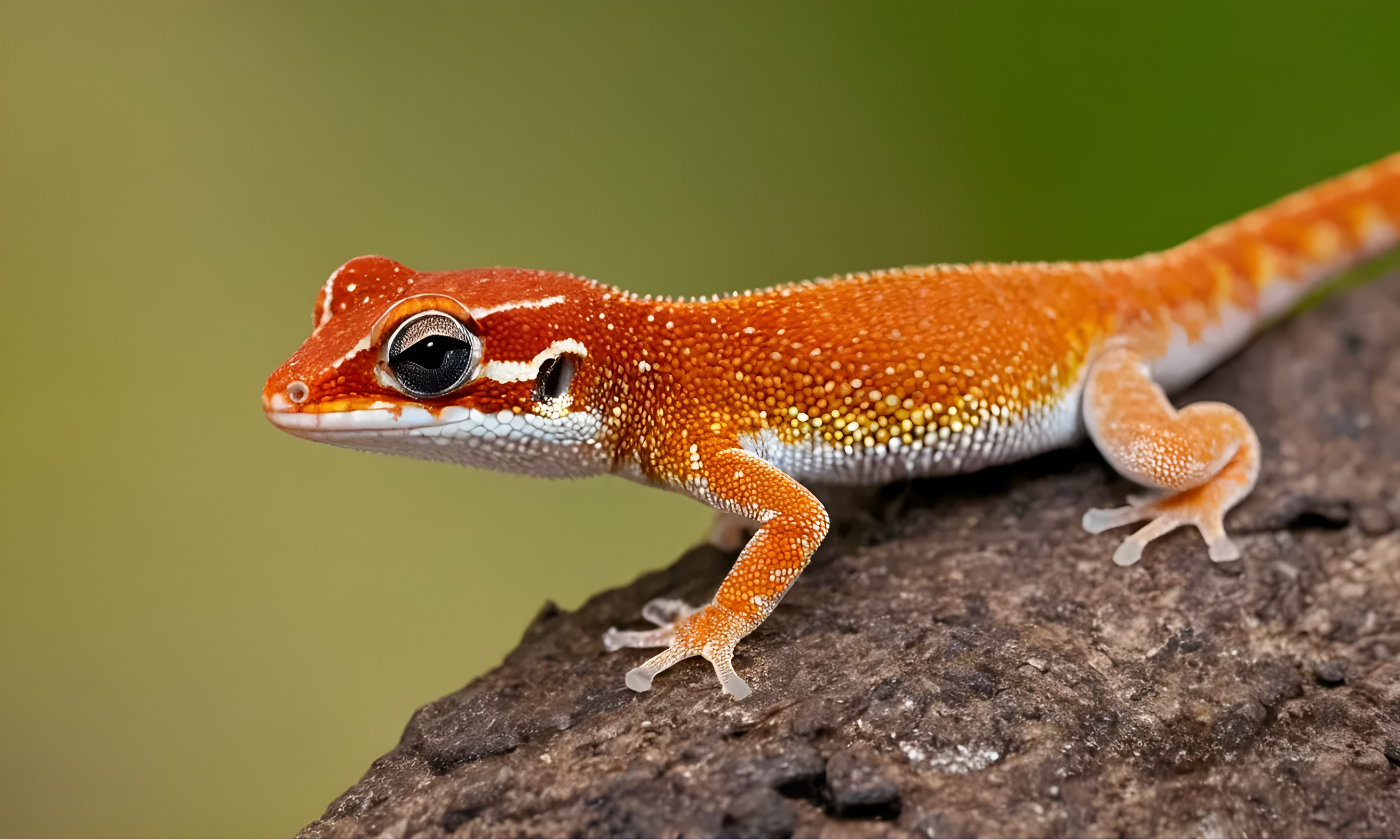
The Virgin Islands Dwarf Gecko is one of the smallest reptiles in the world, measuring just 1-1.5 inches.
It is native to the British Virgin Islands and often hides under rocks. This tiny gecko has a slender body and a long tail.
- Region of Habitat: British Virgin Islands
- Scientific Name: Sphaerodactylus Parthenon
- Place of Origin: British Virgin Islands
- Feeding Habits: Insectivorous
- What Sound They Make: Silent
Fun Facts: The Virgin Islands Dwarf Gecko is one of the smallest reptiles. It was first discovered in 1964 and is known for its baffling nature.
It spends most of its day hiding under rocks and other objects.
21. Vizsla
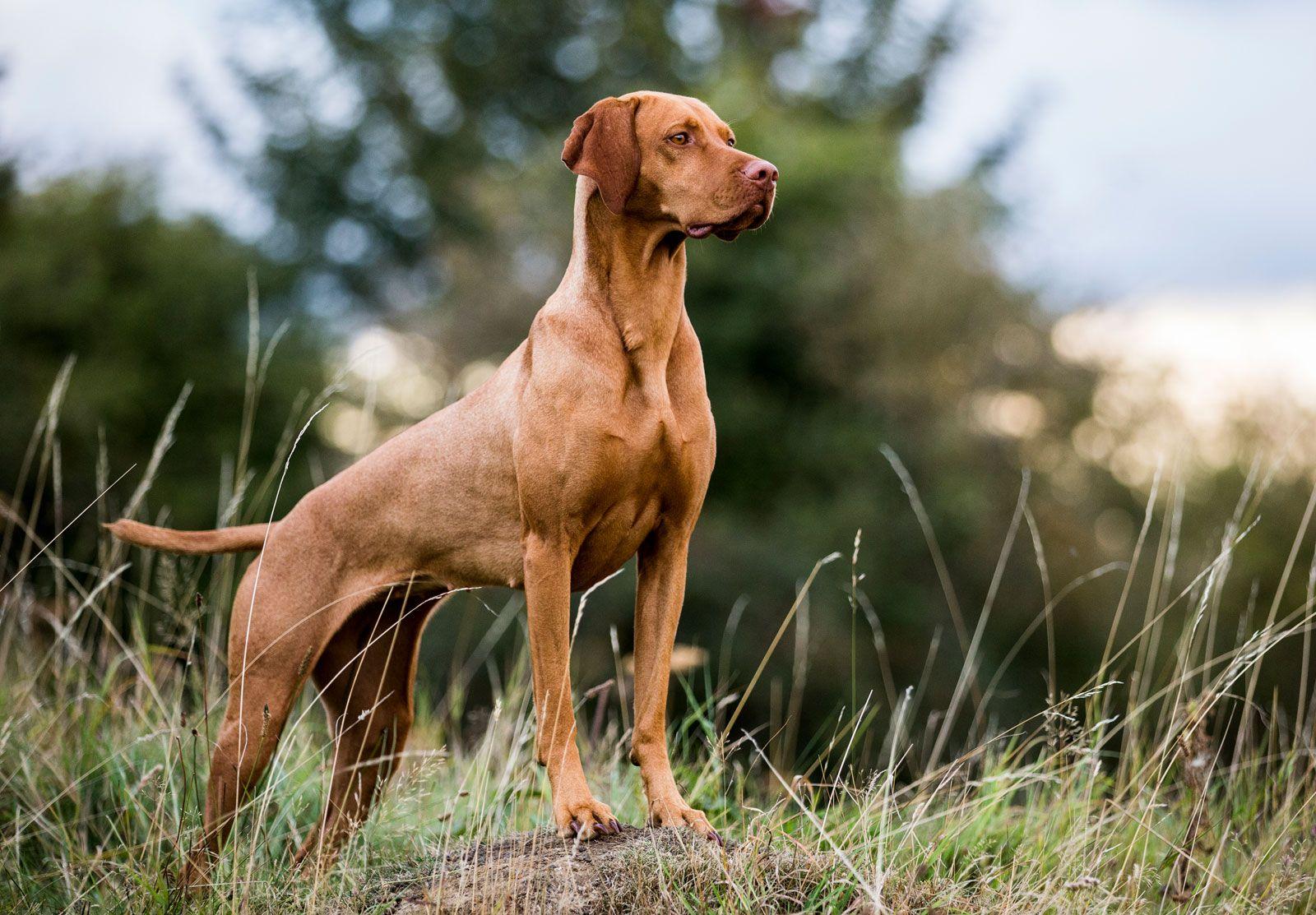
The Vizsla is a sleek, muscular hunting dog known for its excellent tracking abilities.
Originating from Hungary, they are called “Velcro dogs” because they stick close to their owners.
Vizslas have a short, smooth coat and a distinctive reddish-brown color.
- Region of Habitat: Domestic, worldwide
- Scientific Name: Canis lupus familiaris
- Place of Origin: Hungary
- Feeding Habits: Omnivorous, mainly domestic dog food
- What Sound They Make: Barking
Fun Facts: Vizsla means “searcher” or “tracker” in Hungarian, reflecting their outstanding hunting and tracking abilities.
They are also known for their affectionate nature and strong bond with their owners.
22. Volcano Snail
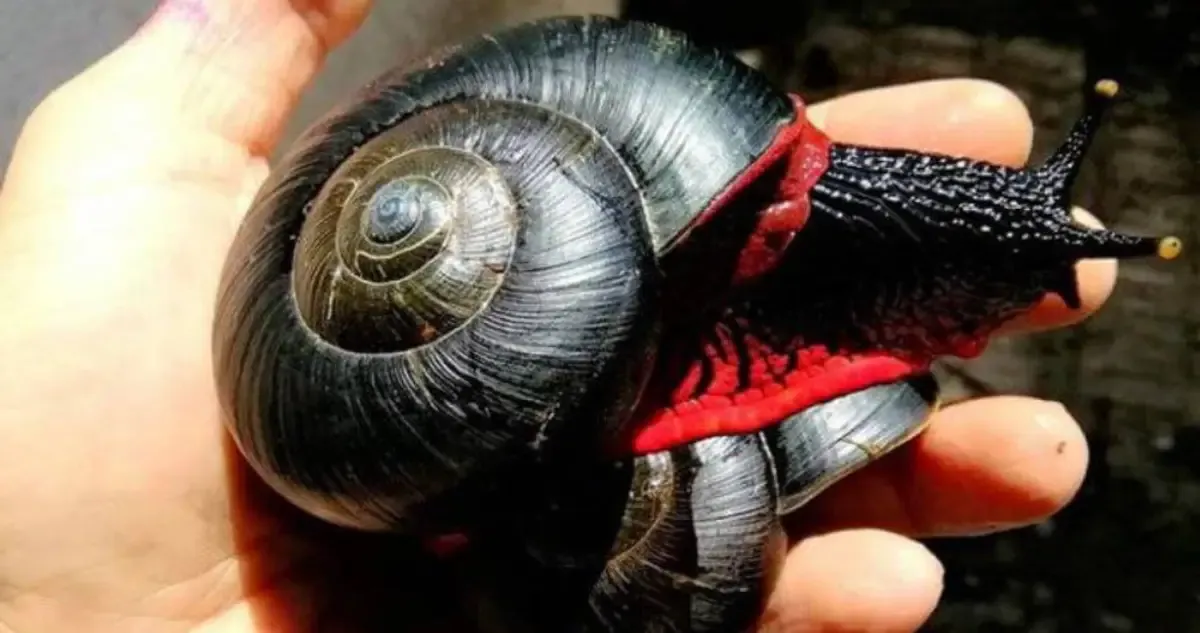
The Volcano Snail, or Scaley-Foot Gastropod, is unique for its iron sulfide shell.
It lives in hydrothermal vent fields on the ocean floor and can withstand extreme heat and toxicity.
The shell’s iron content gives it a unique dark color and durability.
- Region of Habitat: Indian Ocean hydrothermal vents
- Scientific Name: Chrysomallon squamiferum
- Place of Origin: Indian Ocean
- Feeding Habits: Detritivorous, feeds on bacteria
- What Sound They Make: Silent
Fun Facts: The Volcano Snail can withstand temperatures up to 750 degrees Fahrenheit, making it one of the most heat-tolerant animals on Earth.
Its iron-plated shell protects it from predators and the harsh environment.
23. Vole
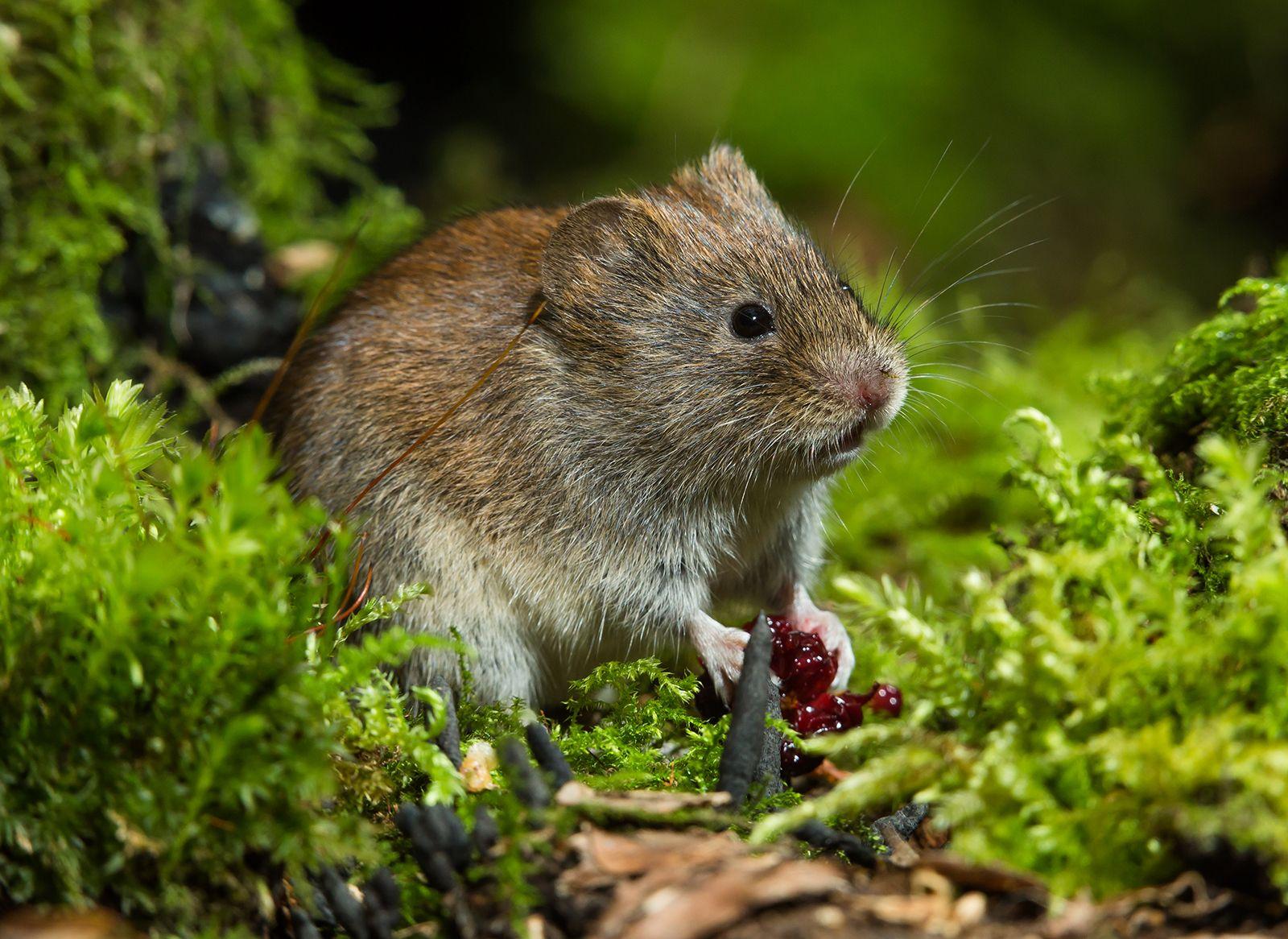
Voles are small rodents resembling mice found in various habitats, including forests and gardens.
They are known for their prolific breeding and burrowing behavior. Voles have a short, stout body and a blunt nose.
- Region of Habitat: Europe, Asia, North America
- Scientific Name: Microtus
- Place of Origin: Worldwide
- Feeding Habits: Herbivorous, feeds on plants and roots
- What Sound They Make: Squeaking
Fun Facts: Voles can cause significant damage to crops and gardens due to their burrowing and feeding habits.
They are often mistaken for mice but have a more powerful body and shorter tails.
24. Volpino Italiano
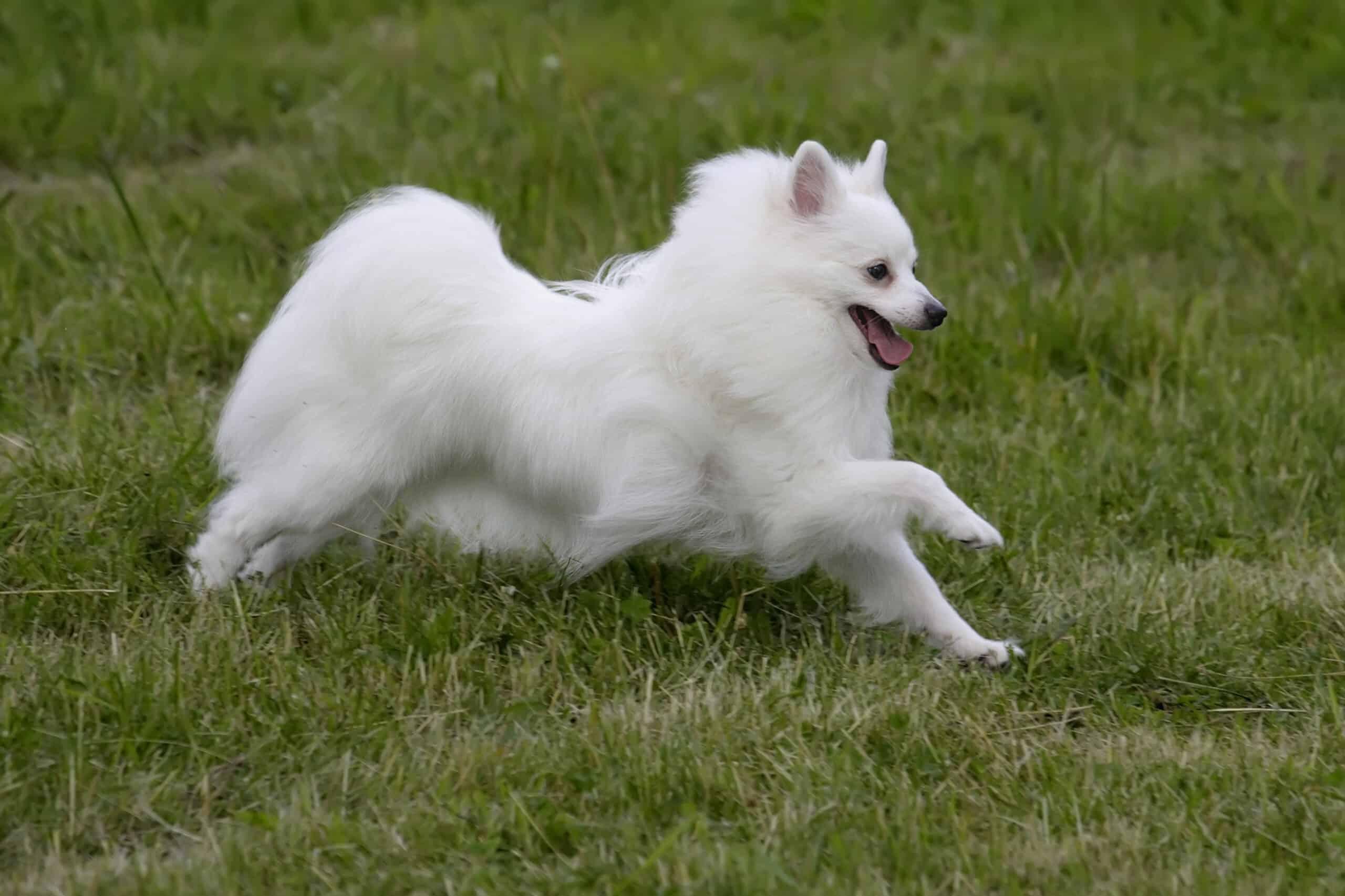
The Volpino Italiano is a small, ancient dog breed from Italy with a fluffy white coat and lively personality.
They were popular among Italian nobility and almost went extinct in the 1980s. Volpinos are known for their alertness and intelligence.
- Region of Habitat: Domestic, primarily in Italy
- Scientific Name: Canis lupus familiaris
- Place of Origin: Italy
- Feeding Habits: Omnivorous, mainly domestic dog food
- What Sound They Make: Barking
Fun Facts: The breed was saved from extinction by the interest of American Eskimo Dog breeders, who recognized their value.
Volpinos are energetic and make excellent watchdogs despite their small size.
25. Vulture
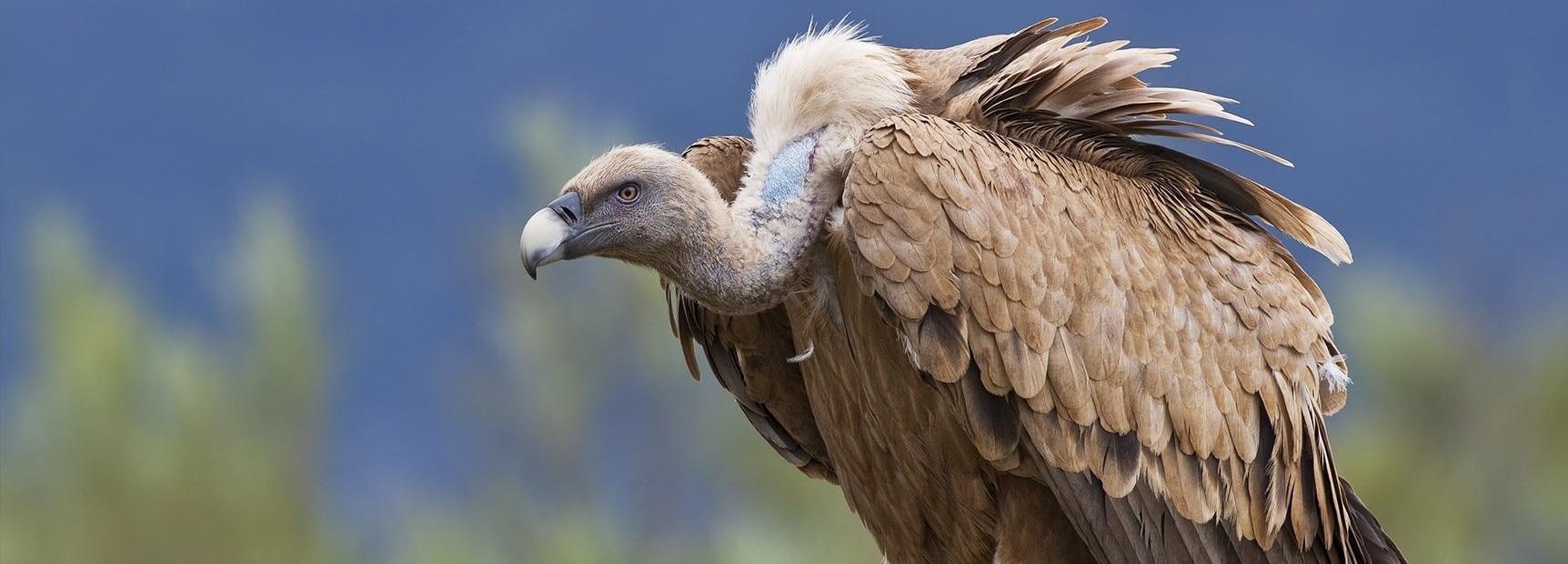
Vultures are large birds of prey known for their scavenging habits. They play a crucial role in the ecosystem by consuming carrion, which helps prevent the spread of diseases.
Their bald heads allow them to stay clean while feeding.
- Region of Habitat: Worldwide
- Scientific Name: Cathartes aura (Turkey Vulture)
- Place of Origin: Worldwide
- Feeding Habits: Scavenger, feeds on carrion
- What Sound They Make: Hissing and grunting
Fun Facts: There are 30 species of vultures worldwide, each adapted to different environments and roles in their ecosystems.
They have highly acidic stomachs that allow them to digest rotting meat without getting sick.
26. Vampire Spider
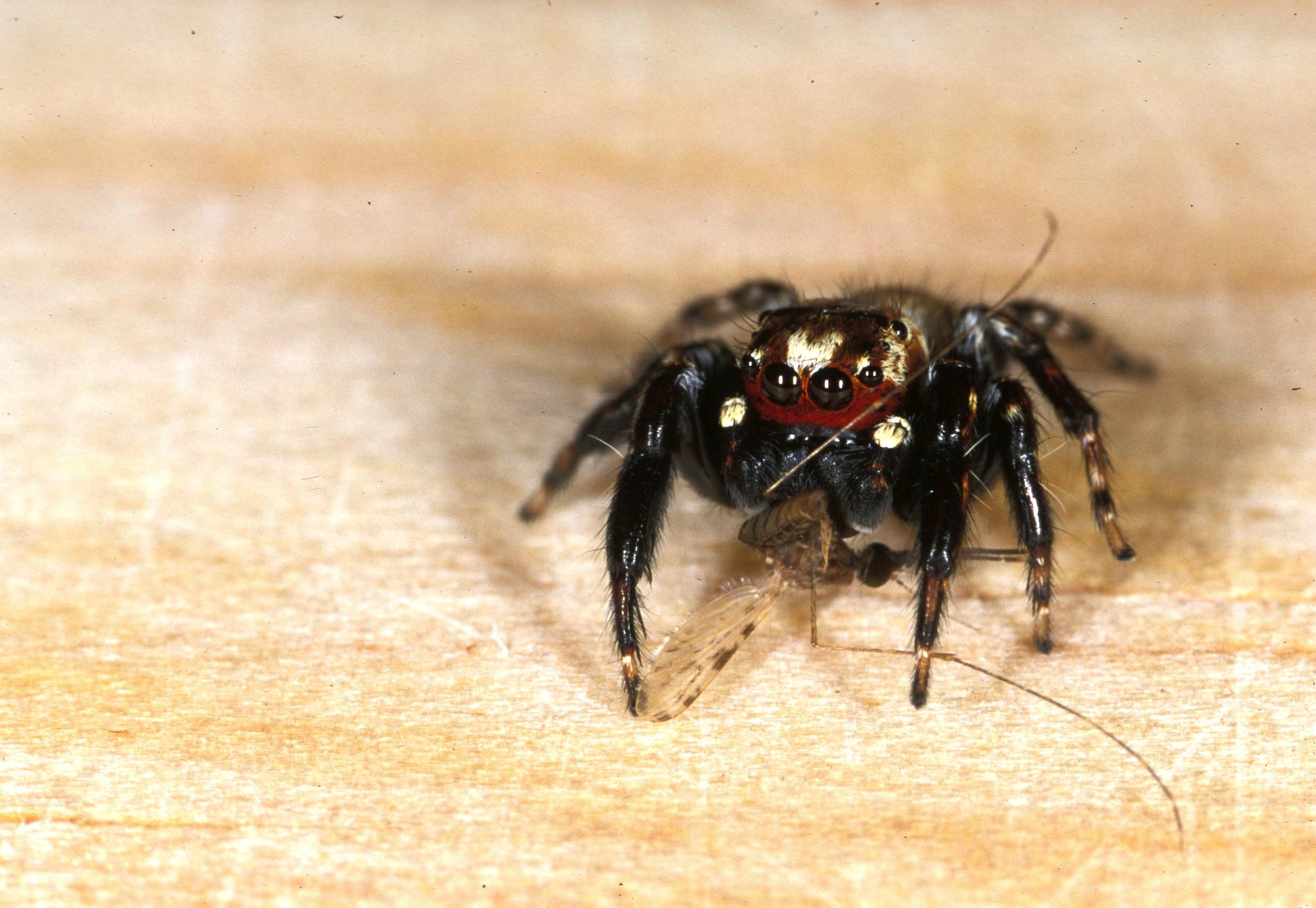
The Vampire Spider is a member of the jumping spider family. It does not feed on blood but preys on blood-fed mosquitoes, using its excellent vision and agility to hunt.
Vampire Spiders are small and have distinctive markings that help them blend into their environment.
- Region of Habitat: Worldwide
- Scientific Name: Evarcha culicivora
- Place of Origin: Various regions
- Feeding Habits: Carnivorous, feeds on blood-fed mosquitoes
- What Sound They Make: Silent
Fun Facts: Vampire spiders have a unique diet, preying on mosquitoes recently fed on blood.
This behavior makes them beneficial in controlling mosquito populations.
27. Velvet Ant
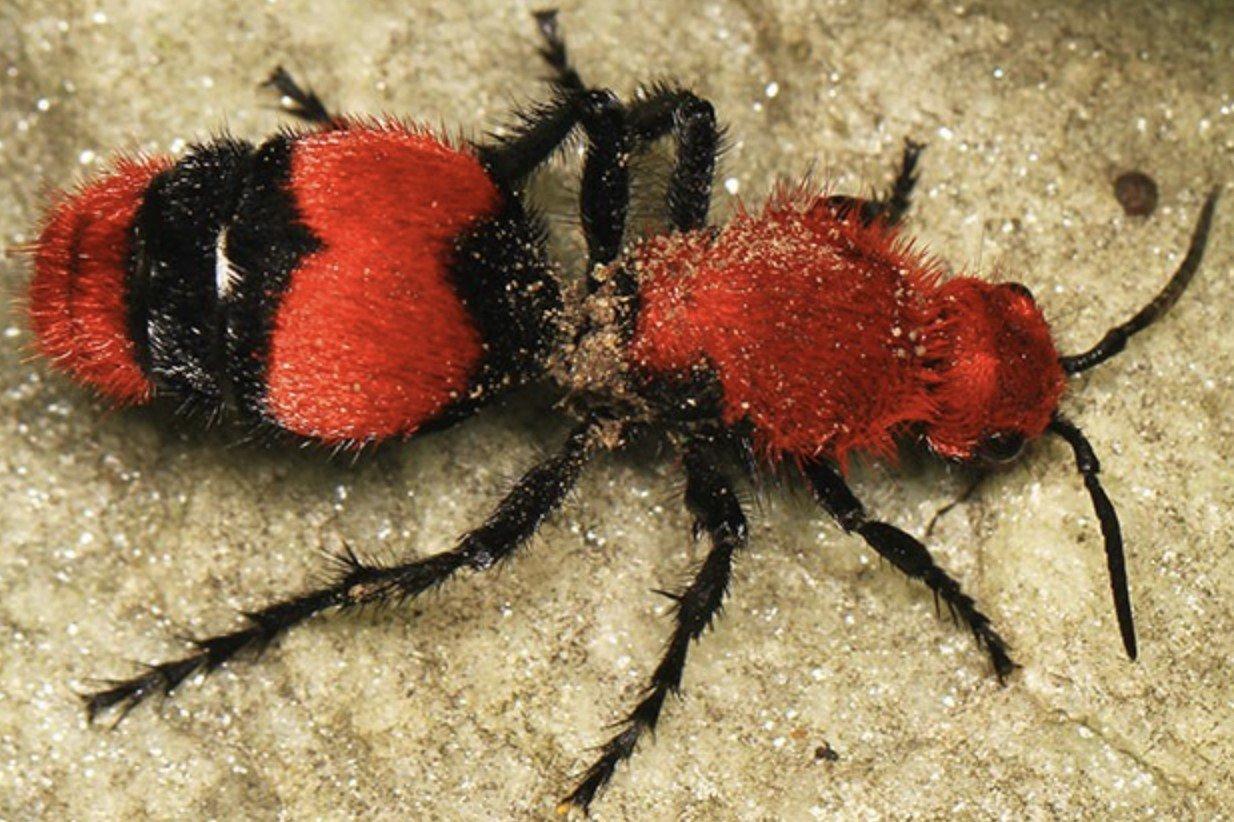
The Velvet Ant is a wingless wasp with bright red or orange coloration and an extremely painful sting.
Velvet ants are solitary and found in various habitats. Their thick, velvety exoskeleton provides protection.
- Region of Habitat: North and South America
- Scientific Name: Dasymutilla occidentalis
- Place of Origin: Americas
- Feeding Habits: Parasitic, feeds on larvae of other insects
- What Sound They Make: Buzzing
Fun Facts: Despite their name, velvet ants are not ants but wasps. Their sting is so painful that they are nicknamed “cow killers.” Females are wingless, while males have wings but cannot sting.
28. Velvet Worm
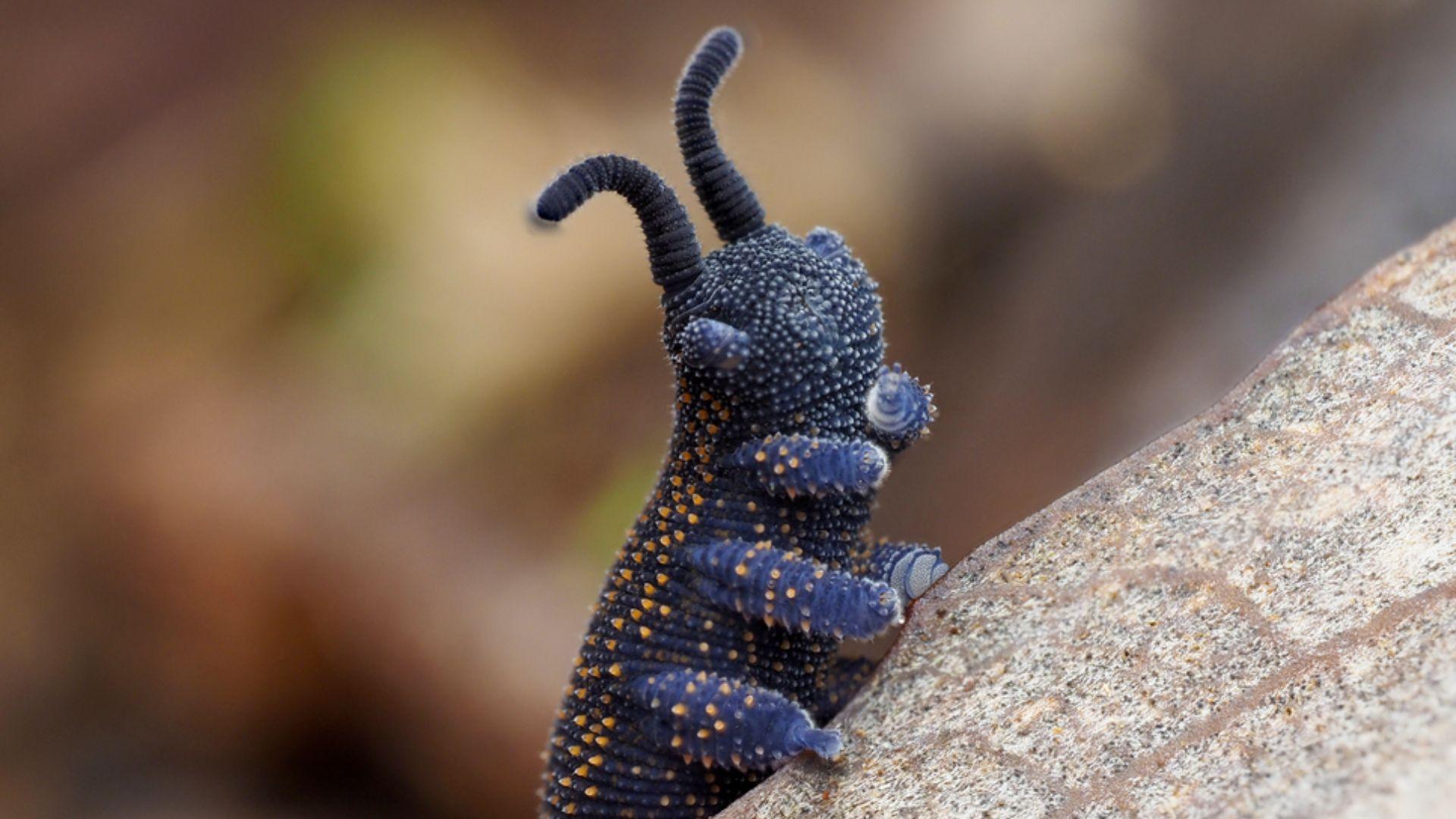
Velvet worms are ancient, soft-bodied invertebrates that have existed for over 500 million years.
Velvet worms capture prey by shooting sticky slime to paralyze it. They have multiple pairs of legs and a segmented body.
- Region of Habitat: Tropical regions worldwide
- Scientific Name: Onychophora
- Place of Origin: Various tropical regions
- Feeding Habits: Carnivorous, feeds on small invertebrates
- What Sound They Make: Silent
Fun Facts: Velvet Worms are known for their unique hunting method, using slime to capture prey.
They have remained relatively unchanged for millions of years, providing a glimpse into early animal evolution.
29. Velvet-fronted Grackle
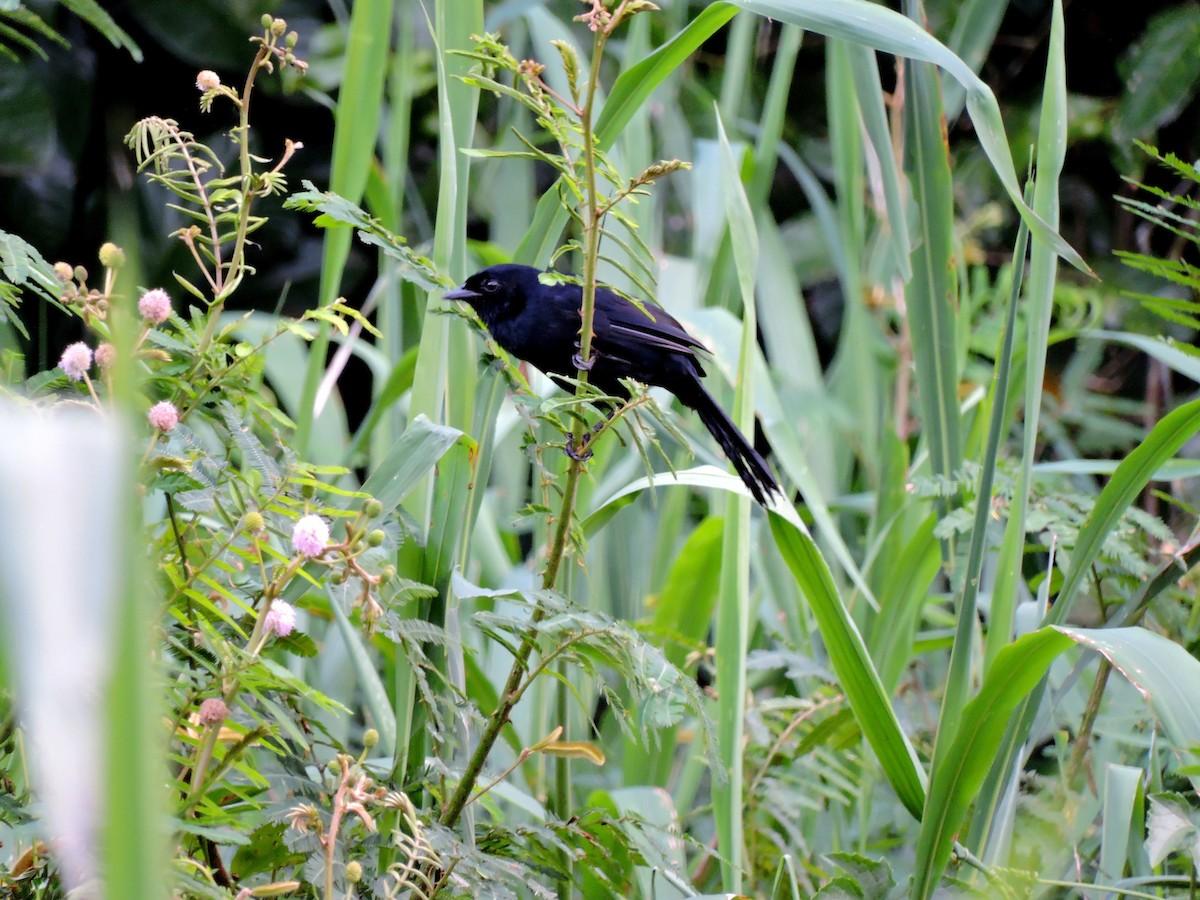
The Velvet-fronted Grackle is a species from South America with glossy black feathers.
Despite its name, it is not a true grackle but a type of cowbird. These birds are social and often seen in flocks.
- Region of Habitat: South America
- Scientific Name: Lampropsar tanagrinus
- Place of Origin: South America
- Feeding Habits: Omnivorous, feeds on seeds and insects
- What Sound They Make: Melodic calls
FunFacts: The Velvet-fronted Grackle is known for its social behavior and shiny, attractive feathers. They often feed in groups, enhancing their chances of finding food.
30. Velvet Scoter
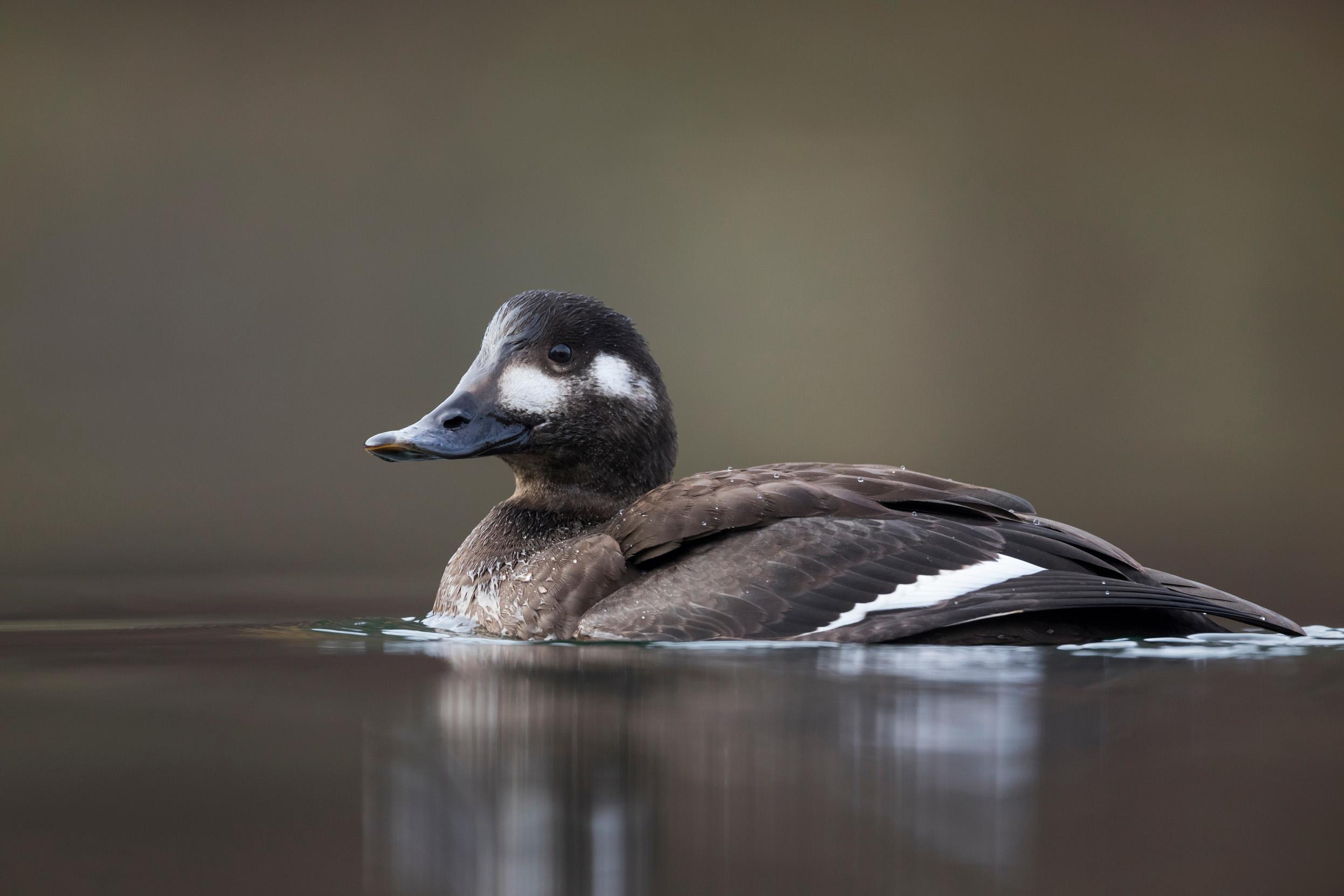
The Velvet Scoter is a large sea duck with striking black and white feathers. They are strong swimmers and divers, often seen grazing for food in northern Europe and Asia.
Velvet Scoters have strong bodies and a distinctive white patch on their wings.
- Region of Habitat: Northern Europe and Asia
- Scientific Name: Melanitta fusca
- Place of Origin: Europe and Asia
- Feeding Habits: Omnivorous, feeds on aquatic invertebrates
- What Sound They Make: Quacking
FunFacts: Velvet Scoters can dive to depths of up to 60 feet to forage for food.
They are excellent divers and use their strong legs and webbed feet to move underwater.
Final Words
Our journey through the world of animals that start with V has been truly eye-opening.
From the tiny vole to the massive vulture, each creature we’ve explored has its unique place in nature’s grand design.
These V-named animals showcase the incredible diversity of life on our planet.
They remind us of the wonders in every corner of the world, from the depths of the oceans to the highest mountain peaks.
Which of these animals captured your imagination? Perhaps you’ve found a new favorite or learned something surprising about a familiar species.
Remember that every animal, including those that start with V, plays a crucial role in its ecosystem.
By appreciating and protecting these creatures, we help maintain the tender balance of our natural world.

